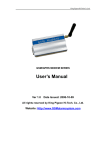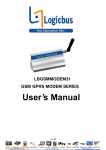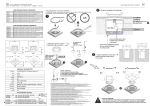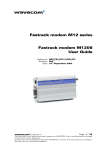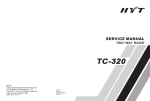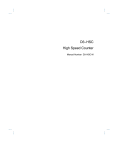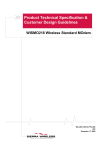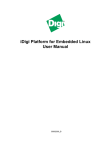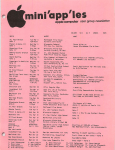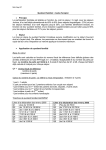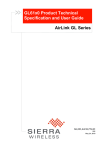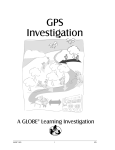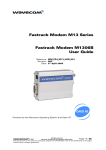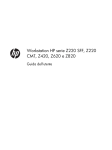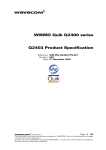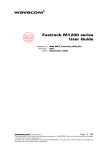Download Documentation - Digi International
Transcript
52 Omnin ® ™ Digi m130 Hardware Reference Manual 90001178_B Release date: April 2011 Omni Technical Specification ©2010 Digi International Inc. Product All rights reserved. Digi®, Digi International®, the Digi logo, a Digi International Company, Digi m130 are trademarks or registered trademarks of Digi International, Inc. in the United States and other countries worldwide. All other trademarks are the property of their respective owners. All other trademarks mentioned in this document are the property of their respective owners. Information in this document is subject to change without notice and does not represent a commitment on the part of Digi International. Digi provides this document “as is,” without warranty of any kind, either expressed or implied, including, but not limited to, the implied warranties of fitness or merchantability for a particular purpose. Digi may make improvements and/or changes in this manual or in the product(s) and/or the program(s) described in this manual at any time. This product could include technical inaccuracies or typographical errors. Changes are periodically made to the information herein; these changes may be incorporated in new editions of the publication. Document History Revision Date A October 2010 B April 2011 © 2010 Digi International Inc. Changes Initial release Detailing the DC ground characteristics in Section 3.19.1.2.3 and Table 42 in Section 3.19.1.1.3 2 Omni Technical Specification Product Contents 1 About This Document .................................................................................... 8 1.1 .Documentation Updates ........................................................................................................... 8 1.2 .Contact Information ................................................................................................................. 8 1.3 .Reference Documents .............................................................................................................. 8 1.3.1 Sierra Wireless Reference Documentation ................................................................. 8 1.3.2 General Reference Documentation ............................................................................. 8 1.4 .List of Abbreviations ............................................................................................................... 9 2 General Description ..................................................................................... 12 2.1 .General Information ............................................................................................................... 12 2.1.1 RoHS Compliance .................................................................................................... 12 2.1.2 Digi m130 Features ................................................................................................... 13 2.1.3 Primary Interfaces ..................................................................................................... 13 2.1.4 Operating System ...................................................................................................... 13 2.2 .Functional Description ........................................................................................................... 14 2.2.1 GSM Functionality ................................................................................................... 15 2.2.2 Orbcomm Functionality ............................................................................................ 15 2.2.3 GPS Functionality ..................................................................................................... 15 2.3 .Operating System ................................................................................................................... 15 3 Interfaces ...................................................................................................... 16 3.1 .Antenna Connectors ............................................................................................................... 16 3.2 .System Connector .................................................................................................................. 17 3.2.1 Reference Part Numbers ........................................................................................... 17 3.2.2 Pinout ........................................................................................................................ 18 3.3 .Power Supply ......................................................................................................................... 20 3.3.1 Power Supply Description ........................................................................................ 20 3.3.2 Recommendations for Reduced Consumption.......................................................... 29 3.4 .Electrical Information for Digital I/O .................................................................................... 30 3.5 .Serial Interface ....................................................................................................................... 31 3.5.1 SPI Bus ..................................................................................................................... 31 3.5.2 I2C Bus ..................................................................................................................... 33 3.6 .Main Serial Link (UART1) .................................................................................................... 35 3.6.1 Features ..................................................................................................................... 35 3.6.2 Pin Description of UART1 Interface ........................................................................ 35 3.7 .Auxiliary Serial Link (UART2) ............................................................................................. 39 3.7.1 Features ..................................................................................................................... 39 3.8 .General Purpose Input/Output ............................................................................................... 40 3.9 .Analog to Digital Converters ................................................................................................. 41 3.9.1 Features ..................................................................................................................... 41 3.9.2 Pin Description ......................................................................................................... 41 © 2010 Digi International Inc. 3 Omni Technical Specification 3.10 Digital to Analog Converter ............................................................................................... 42 3.10.1 Features ..................................................................................................................... 42 3.10.2 Pin Description ......................................................................................................... 42 Product 3.11 Analog Audio Interface ...................................................................................................... 43 3.11.1 Microphone Input ..................................................................................................... 43 3.11.2 Speaker Output Characteristics ................................................................................. 45 3.11.3 Design Recommendation .......................................................................................... 46 3.11.4 Buzzer Output ........................................................................................................... 49 3.12 PWR_ENB_N ..................................................................................................................... 51 3.12.1 Features ..................................................................................................................... 51 3.12.2 Pin Description ......................................................................................................... 51 3.12.3 Application................................................................................................................ 51 3.13 HW_SD Signal ................................................................................................................... 54 3.14 External Interrupt ................................................................................................................ 56 3.15 BOOT Signal ...................................................................................................................... 56 3.15.1 Features ..................................................................................................................... 57 3.15.2 Pin Description ......................................................................................................... 57 3.15.3 Application................................................................................................................ 57 3.16 VREF_2V8 Output ............................................................................................................. 58 3.17 BAT-RTC (Backup Battery)............................................................................................... 59 3.17.1 Interface Description................................................................................................. 59 3.18 FLASH-LED Signal ........................................................................................................... 60 3.19 RF Interface ........................................................................................................................ 61 3.19.1 RF Performance ........................................................................................................ 61 3.20 Environmental Specifications ............................................................................................. 70 3.21 Mechanical Specifications .................................................................................................. 71 3.22 Antenna Suppliers............................................................................................................... 71 3.23 Standards and Recommendations ....................................................................................... 73 3.24 Declaration of Conformity .................................................................................................. 77 3.25 Safety Recommendations (for Information Only) .............................................................. 78 3.25.1 RF Safety .................................................................................................................. 78 3.25.2 General Safety........................................................................................................... 79 © 2010 Digi International Inc. 4 Omni Technical Specification Product List of Figures Figure 1: Top Level Architecture.................................................................................................................................... 14 Figure 2: Power supply during burst emission................................................................................................................ 20 Figure 3: Connected Mode Current Waveform .............................................................................................................. 24 Figure 4: Slow Idle Mode Current Waveform ................................................................................................................ 25 Figure 5: Fast Idle Mode Current Waveform.................................................................................................................. 25 Figure 6: Transfer Mode Class 10 Current Waveform ................................................................................................... 26 Figure 7: SPI Timing diagrams, Mode 0, Master, 4 wires .............................................................................................. 32 Figure 8: I²C Timing diagrams, Master .......................................................................................................................... 34 Figure 9: Example of V24/CMOS serial link implementation for UART1.................................................................... 37 Figure 10: Example of full modem V24/CMOS serial link implementation for UART1 .............................................. 38 Figure 11: Example of MIC input connection with LC filter ......................................................................................... 44 Figure 12: Example of MIC input connection without LC filter .................................................................................... 44 Figure 13: Example of Speaker connection .................................................................................................................... 46 Figure 14: Capacitor near Microphone........................................................................................................................... 46 Figure 15: Audio track design ........................................................................................................................................ 48 Figure 16: Example of buzzer implementation............................................................................................................... 50 Figure 17: Example of LED driven by the BUZZ-OUT output ..................................................................................... 50 Figure 18: Example of ON/~OFF pin connection........................................................................................................... 51 Figure 19: Power-ON sequence (no PIN code activated) ............................................................................................... 52 Figure 20: Power-OFF sequence .................................................................................................................................... 54 Figure 21: Proper shut down sequence ........................................................................................................................... 55 Figure 22: Shut down timing diagram ............................................................................................................................ 55 Figure 23: Boot Selection Application Example ............................................................................................................ 57 Figure 24: Real Time Clock power supply..................................................................................................................... 59 Figure 25: GPS TTFF, Hot Start Configuration ............................................................................................................. 64 Figure 26: GPS TTFF, Warm Start Configuration ......................................................................................................... 65 Figure 27: GPS TTFF, Simulator Cold Start Configuration........................................................................................... 66 Figure 28: First Position Fix Accuracy Chart 01 ............................................................................................................ 67 Figure 29: First Position Fix Accuracy Chart 02............................................................................................................ 68 Figure 30: First Position Fix Accuracy Chart 03 ............................................................................................................ 69 Figure 31: Environmental classes ................................................................................................................................... 70 © 2010 Digi International Inc. 5 Omni Technical Specification Product List of Tables Table 1: GSM /GPRS Frequency .................................................................................................................................... 15 Table 2: Antenna Connectors (Coding, Keying)............................................................................................................. 16 Table 3: System Connector Reference Part Numbers ..................................................................................................... 17 Table 4: System connector pinout ................................................................................................................................... 19 Table 5: Power Supply Voltage ...................................................................................................................................... 20 Table 6: GSM power consumption without Open AT processing .................................................................................. 22 Table 7: Power consumption with Dhrystone benchmark Open AT application ........................................................... 23 Table 8: Power Supply Pin-out ....................................................................................................................................... 28 Table 9: CMOS Output / Input Electrical Characteristics for 2.8 volt signals................................................................ 30 Table 10: CMOS Output / Input Electrical Characteristics for 1.8 volt signals.............................................................. 30 Table 11: Open Drain Electrical Characteristics............................................................................................................. 30 Table 12: SPI Bus AC characteristics ............................................................................................................................. 32 Table 13: SPI Bus Configuration.................................................................................................................................... 32 Table 14: SPI Bus Pin description .................................................................................................................................. 33 Table 15: I²C Bus AC characteristics ............................................................................................................................. 34 Table 16: IC Bus Pin Description ................................................................................................................................... 34 Table 17: UART1 Pin Description.................................................................................................................................. 35 Table 18: UART2 Pin Description.................................................................................................................................. 39 Table 19: GPIOs Pin Description ................................................................................................................................... 40 Table 20: ADCs Electrical Characteristics ..................................................................................................................... 41 Table 21: ADCs Pin Description .................................................................................................................................... 41 Table 22: DAC Electrical Characteristics ...................................................................................................................... 42 Table 23: DAC Pin Description...................................................................................................................................... 42 Table 24: MIC2 Pin Description..................................................................................................................................... 43 Table 25: MIC2 Electrical Characteristics ..................................................................................................................... 43 Table 26: SPK Pin Description ....................................................................................................................................... 45 Table 27: SPK Electrical Characteristics ....................................................................................................................... 45 Table 28: Audio filtering Examples with Murata Components ...................................................................................... 47 Table 29: PWM/Buzzer Output Electrical Characteristics ............................................................................................. 49 Table 30: PWM/Buzzer Output Pin Description ............................................................................................................ 49 Table 31: External Interrupt Pin description .................................................................................................................. 56 Table 32: External Interrupt Electrical Characteristics................................................................................................... 56 Table 33: Boot Signal Mode ........................................................................................................................................... 57 Table 34: Boot Pin Description ...................................................................................................................................... 57 Table 35: VREF_2V8 Pin Description ........................................................................................................................... 58 © 2010 Digi International Inc. 6 Omni Product Technical Specification Table 36: VREF_2V8 Electrical Characteristics ............................................................................................................ 58 Table 37: Bat-RTC Pin Description ............................................................................................................................. 59 Table 38: Bat-RTC Electrical Characteristics ................................................................................................................ 59 Table 39: Flash-LED Status ........................................................................................................................................... 60 Table 40: Flash-LED Pin Description ............................................................................................................................ 60 Table 41: Flash-LED Electrical Characteristics ............................................................................................................. 60 Table 42: GSM Antenna Specifications ......................................................................................................................... 62 Table 43: GPS Performance ........................................................................................................................................... 64 © 2010 Digi International Inc. 7 Omni Technical Specification Product 1 About This Document This document outlines the technical specifications and design integration related aspects of the Digi m130 dual-mode modem. The Digi m130 product, formerly known as Wavecom® Q52 Omni / Sierra Wireless™ AirPrime™ Q52 Omni, is owned and sold by Digi International, Inc. All regulatory related certifications are in the process of being transferred to Digi International as part of the official product rebranding process. The product design was not modified. Customers are able to use the product based on existing certifications while the regulatory ownership transition is in progress. 1.1 Documentation Updates Please always check the product specific section on the Digi support website at www.digiembedded.com/support for the most current revision of this guide and other product related documents. 1.2 Contact Information For more information about Digi products, or for customer service and technical support, please contact us. World Wide Webhttp://www.digiembedded.com/support E-Mail [email protected] Telephone (U.S.)+1 952 912-3444 or (877) 912-3444 Telephone (other locations)+1 952 912-3444 References 1.3 Reference Documents For more details, several reference documents may be consulted. The Sierra Wireless reference documents are provided in the Sierra Wireless document package, which are not authored by Digi International. 1.3.1 Sierra Wireless Reference Documentation [1] ADL User Guide for OS v6.00 or later. Reference: WM_DEV_OAT_UGD_080 [2] DWLWin Download Application User. Guide. Reference: WM_DEV_TOO_UGD_010 [3] AT Command Interface Guide for Open AT® Firmware v7.0 or later. Reference: WM_DEV_OAT_UGD_059 1.3.2 General Reference Documentation [4] “I²C Bus Specification”, Version 2.0, Philips Semiconductor 1998 [5] ISO 7816-3 Standard © 2010 Digi International Inc. 8 Omni Technical Specification 1.4 Product List of Abbreviations Abbreviation Definition AC Alternating Current ADC Analog to Digital Converter A/D Analog to Digital conversion AF Audio-Frequency AT ATtention (prefix for modem commands) AUX AUXiliary CAN Controller Area Network CB Cell Broadcast CEP Circular Error Probable CLK CLocK CMOS Complementary Metal Oxide Semiconductor CS Coding Scheme CTS Clear To Send DAC Digital to Analog Converter dB Decibel DC Direct Current DCD Data Carrier Detect DCE Data Communication Equipment DCS Digital Cellular System DR Dynamic Range DSR Data Set Ready DTE Data Terminal Equipment DTR Data Terminal Ready EFR Enhanced Full Rate E-GSM Extended GSM EMC ElectroMagnetic Compatibility EMI ElectroMagnetic Interference EMS Enhanced Message Service EN ENable ESD ElectroStatic Discharges FIFO First In First Out FR Full Rate FTA Full Type Approval GND GrouND © 2010 Digi International Inc. 9 Omni Technical Specification Abbreviation Definition GPI General Purpose Input GPC General Purpose Connector GPIO General Purpose Input Output GPO General Purpose Output GPRS General Packet Radio Service GPS Global Positioning System GSM Global System for Mobile communications HR Half Rate I/O Input / Output LED Light Emitting Diode LNA Low Noise Amplifier MAX MAXimum MIC MICrophone MIN MINimum MMS Multimedia Message Service MO Mobile Originated MT Mobile Terminated na Not Applicable NF Noise Factor NMEA National Marine Electronics Association NOM NOMinal NTC Negative Temperature Coefficient PA Power Amplifier Pa Pascal (for speaker sound pressure measurements) PBCCH Packet Broadcast Control CHannel PC Personal Computer PCB Printed Circuit Board PDA Personal Digital Assistant PFM Power Frequency Modulation PSM Phase Shift Modulation PWM Pulse Width Modulation RAM Random Access Memory RF Radio Frequency RFI Radio Frequency Interference RHCP Right Hand Circular Polarization RI Ring Indicator RST ReSeT © 2010 Digi International Inc. Product 10 Omni Technical Specification Abbreviation Definition RTC Real Time Clock RTCM Radio Technical Commission for Maritime services RTS Request To Send RX Receive SCL Serial CLock SDA Serial DAta SIM Subscriber Identification AirPrime WMP100 CPU SMS Short Message Service SPI Serial Peripheral Interface SPL Sound Pressure Level SPK SPeaKer SRAM Static RAM TBC To Be Confirmed TDMA Time Division Multiple Access TP Test Point TVS Transient Voltage Suppressor TX Transmit TYP TYPical UART Universal Asynchronous Receiver-Transmitter USB Universal Serial Bus USSD Unstructured Supplementary Services Data VSWR Voltage Standing Wave Ratio © 2010 Digi International Inc. Product 11 Omni Technical Specification Product 2 General Description 2.1 General Information The Digi m130 is a dual-mode GSM/Orbcomm transceiver consisting of an E-GSM/GPRS 900/1800 and 850/1900 quad-band GSM transceiver combined with a full function Orbcomm transceiver. An optional high performance GPS receiver is also available, giving a system integrator the ability to design a global coverage asset tracking device with minimal external circuitry. A Digi m130 user always has complete control of the active communication modes and GPS receiver operations. One or both communication transceivers can be active while the AirPrime WMP100 CPU is performing continuous GPS location. The internal ARM9 microcontroller runs a multi-tasking OS to execute all GSM functionality while transparently providing up to 80 MIPS of excess processing power for the user’s embedded firmware application. Five megabytes of flash memory and 1.5 megabytes of RAM are available for the user specific C language application code. 2.1.1 RoHS Compliance The Digi m130 is compliant with RoHS (Restriction of Hazardous Substances in Electrical and Electronic Equipment) Directive 2002/95/EC which sets limits for the use of certain restricted hazardous substances. This directive states that “from 1st July 2006, new electrical and electronic equipment put on the market does not contain lead, mercury, cadmium, hexavalent chromium, polybrominated biphenyls (PBB) or polybrominated diphenyl ethers (PBDE)”. © 2010 Digi International Inc. 12 Omni Technical Specification Product 2.1.2 Digi m130 Features • • • Cellular Connectivity o 2-Watt EGSM 900/GSM 850 radio o 1-Watt GSM1800/1900 radio o GPRS class 10 capable Satellite Connectivity o 5-Watt Orbcomm Satellite Transceiver o Digi ASIC Transceiver Technology Optional GPS Receiver 2.1.3 Primary Interfaces • Power supply • 2 * UARTs Serial links • GSM Analog audio • Serial Protocol Interface (SPI) • I2C Interface • 2 A/D inputs and 1 D/A output • Digital I/Os • GSM , GPS † and Orbcomm antenna ports 2.1.4 Operating System * † • Real Time Clock with calendar • Echo Cancellation + noise reduction (quadri codec) • Full GSM and GPRS support • Full Orbcomm protocol stack • Full GPS protocol stack† On Digi m130 variant without GPS functionality Depending on product variant in use © 2010 Digi International Inc. 13 © 2010 Digi International Inc. 40-Pin System Connector ON/OFF 3.6V AirPrime WMP100 Wireless CPU GSM SIM 32 kHz XTAL SPI Interface Reset Watchdog Interruption Power On *: Serial UART 2 is available on connector only on variants without GPS Power Enable GND +3.6Vdc 11 -16 Vdc RTC Battery VREF Serial UART 1 I2C Interface SPI Interface LED Driver Buzzer Driver DAC ADC0 ADC1 Audio Interface Flash Memory 3.6V OPUS State Machine Power Supply Regulators SDRAM DSP Program Memory Blackfin DSP PSRAM Memory Temp sensor Serial UART 2* 3.3 V External Synthesizer Digi Satellite RF/Baseband ASIC Orbcomm TCXO Tracking Acquisition RF Receiver RF Transmitter Prelude III RF Receiver Orbcomm Antenna Connection 9.5V T/R Switch Orbcomm Transceiver GPS Optional GPS Antenna Connection 2.2 External Interrupt Serial UART 2* GSM/GPRS Antenna Connection Omni Technical Specification Product Functional Description The top level architecture of the Digi m130 is described below: Figure 1: Top Level Architecture 14 Omni Technical Specification Product 2.2.1 GSM Functionality The Radio Frequency (RF) range of the GSM transceiver complies with the Phase II EGSM 900/DCS 1800 and GSM 850/PCS 1900 recommendations. The frequencies are: Transmit band (Tx) Receive band (Rx) GSM 850 824 to 849 MHz 869 to 894 MHz E-GSM 900 880 to 915 MHz 925 to 960 MHz DCS 1800 1710 to 1785 MHz 1805 to 1880 MHz PCS 1900 1850 to 1910 MHz 1930 to 1990 MHz Table 1: GSM /GPRS Frequency Voice, SMS, and GPRS data services are available either by employing the Digi m130 as a modem device connected to a user’s external processor by the UART1 link, or available through a C API to the user’s embedded Open AT software application running on the Digi m130 ARM9 microprocessor. 2.2.2 Orbcomm Functionality The Digi m130 Orbcomm transceiver provides a wide area packet switched two-way communication capability. Communication between the Digi m130 and the Orbcomm Gateway is accomplished through a constellation of lowEarth orbit satellites, orbiting approximately 500 miles above the earth. Radio frequency communication within the Orbcomm system operates in the VHF portion of the frequency spectrum between 137 and 150 Megahertz. Orbcomm packet data services can be accessed via a user’s external application over the UART1 link or from a user’s embedded Open AT software application running on the Digi m130 ARM9 microprocessor. 2.2.3 GPS Functionality The optional Digi m130 GPS receiver provides position location and tracking capabilities that can be accessed by an external application over a NMEA UART link or from a C API available to the user’s embedded Open ATsoftware application running on the Digi m130 ARM9 microprocessor. 2.3 Operating System The Operating System offers an extensive set of AT commands to control both the GSM and Orbcomm functionality of the AirPrime WMP100 CPU. The Operating System of the AirPrime WMP100 CPU is Open AT. This enables customers to implement market and application specific functionality. © 2010 Digi International Inc. 15 Omni Technical Specification Product 3 Interfaces 3.1 Antenna Connectors The Digi m130 provides FAKRA-type RF antenna connectors with double-locking mechanism, keying, and interface specific color-coding. See table below for additional information. Interface Color Key GSM Bordeaux Violet D GPS Blue C Satellite Curry K Diagram Table 2: Antenna Connectors (Coding, Keying) © 2010 Digi International Inc. 16 Omni Technical Specification 3.2 Product System Connector The main system connector is a keyed ODU MINI-FLAKAFIX 40-pin connector with 1.27 mm pitch. 3.2.1 Reference Part Numbers The table below provides corresponding ODU reference part numbers. Delivery Option (nnn) Description ODU P/N 002 (Tube) System Connector 515.569.035.040.nnn Mating Ribbon Connector 525.060.035.040.nnn 15 SMT Mating Header 525.041.035.040.nnn 15 Ribbon Cable (AWG 30) 921.659.031.040.000 003 (Tube) 010 (Box) 14 050 (Tape) 530 30 400 Table 3: System Connector Reference Part Numbers Please visit the ODU website at www.odu.de for detailed technical specifications as well as regional contact and order information © 2010 Digi International Inc. 17 Omni Technical Specification Product 3.2.2 Pinout Pin Signal Description Dir Pin Type 1 BUZZ-OUT Buzzer Output O Open Drain 2 VREF_2V8 Logic Voltage Reference O V-Ref 3 FLASH-LED Flash LED Driver O Open Drain 4 BAT-RTC Battery for RTC 5 GND Chassis Ground Ground 6 GND Chassis Ground Ground 7 SPK2 Speaker Audio from AirPrime WMP100 CPU 8 GND Chassis Ground Ground 9 AGND Analog Reference Ground 10 MIC2 Microphone Audio to AirPrime WMP100 CPU I Audio 11 DAC0 8 bit D/A Converter Output O 0 - 2 volts 12 PWR_ENB_N Switches the AirPrime WMP100 CPU ON I CMOS_2V8 13 ADC0 10 bit A/D Converter Input I 0 - 2 volts 14 ADC1 10 bit A/D Converter Input I 0 - 2 volts 15 HW_SD Hardware Shutdown 16 EXT-INT 17 18 I/O O Alternate Function Power Audio I/O CMOS_2V8 External Interrupt Signal I CMOS_2V8 GPIO46 SPI-I SPI Input (four wire interface) I CMOS_2V8 GPIO30 SPI1-IO SPI1 Out (four wire interface) CMOS_2V8 GPIO29 I/O CMOS_2V8 GPIO28 O CMOS_2V8 GPIO31 O SPI1 IO (three wire interface) I/O 19 SPI-CLK SPI1 Clock 20 SPI-CS SPI1 Chip Select 21 GND Chassis Ground Ground 22 GND Chassis Ground Ground 23 DCD1 Data Carrier Detect_UART1 O CMOS_2V8 GPIO43 24 RI1 Ring Indicator_UART1 O CMOS_2V8 GPIO42 25 CTS1 Clear to Send_UART1 O CMOS_2V8 GPIO39 26 DTR1 Data Terminal Ready_UART1 I CMOS_2V8 GPIO41 27 TXD1 Transmit Data_UART1 I CMOS_2V8 GPIO36 28 RTS1 Request to Send_UART1 I CMOS_2V8 GPIO38 29 VCC_12V 12 VDC supply input I Power 30 RXD1 Receive Data_UART1 O CMOS_2V8 © 2010 Digi International Inc. GPIO37 18 Omni Technical Specification Pin Signal Product Description Dir Pin Type Alternate Function 31 VCC_12V 12 VDC supply input I Power 32 VCC_12V 12 VDC supply input I Power 33 VCC_3V8 3.8 VDC regulated supply I Power 34 VCC_3V8 3.8 VDC regulated supply I Power 35 SDA_I2C I2C Data I/O Open Drain GPIO27 36 SCL_I2C I2C Clock O Open Drain GPIO26 37 TXD2 Transmit Data_UART2 I CMOS_1V8 GPIO14 38 CTS2 Clear to Send_UART2 O CMOS_1V8 GPIO16 39 RXD2 Receive Data_UART2 O CMOS_1V8 GPIO15 40 RTS2 Request to Send_UART2 I CMOS_1V8 GPIO17 Table 4: System connector pinout © 2010 Digi International Inc. 19 Omni Technical Specification 3.3 Product Power Supply 3.3.1 Power Supply Description The power supply required for the Digi m130 is a dual rail supply; VCC_3V8 and VCC_12V. VCC_12V is only required to support Orbcomm mode operation. VCC_3V8 is used for GSM/GPRS, Orbcomm and GPS operation. The power supply is one of the key issues in the design of a dual mode terminal. Getting full performance from the AirPrime WMP100 CPU requires particularly careful attention to the ability of the power supplies to provide clean DC power. Due to the burst emission modes used in GSM/GPRS, and Orbcomm communication, the VCC_3V8 and VCC_12V8 power supplies must be able to deliver high current peaks in a short time. During the peaks, the ripple (Uripp) on these supply voltages must not exceed a certain limit (see Table 5: Power Supply Voltage). Figure 2 below shows a typical current waveform during a GSM voice transmission. VCC 3V8 Uripp Uripp t = 577 µs T = 4,615 ms Figure 2: Power supply during burst emission VCC_3V8 Supplies the GSM, Orbcomm, and GPS RF components. It is essential to keep a minimum voltage ripple at this connection in order to avoid any degradation in system performance. Supplies the GSMRF Power Amplifier current (2.0 A peak) flows with a duty factor of 1/8 of the time (around 577µs every 4.615ms for GSM /GPRS cl. 2) and 2/8 of the time (around 1154µs every 4.615ms for GSM /GPRS cl. 10) with a typical rise time of 10µs. VCC_12V8 Supplies the Orbcomm transmitter current (2.0 A peak). Transmit burst duration is 450ms worst case with a maximum duty factor of less than 10%. In typical applications only a few burst transmissions occur per day. Vmin Vnom Vmax Ripple max (Uripp) VCC_12V 11.0 13.6 16.0 TBD mVpp VCC_3V81,2 3.6 3.8 4.0 200mVrms Table 5: Power Supply Voltage (1): This value has to be guaranteed during the burst (with 2.0A Peak in GSM or GPRS mode) (2): Max operating Voltage Stationary Wave Ratio (VSWR) 2:1 When the AirPrime WMP100 CPU is in Alarm mode, no voltage must be applied on any pin of the 40-pin connector except on VRTC (pin 4) for RTC operation or PWR_EN (pin 12) to power ON the dual mode Transceiver. © 2010 Digi International Inc. 20 Omni Product Technical Specification When supplying the Digi m130 with power through a battery, the total impedance (battery+protections+PCB) on 3V8 should be <150 mOhms. 3.3.1.1 Power Consumption Power consumption estimates for the Digi m130 are relatively complex due to the multimode capability of the AirPrime WMP100 CPU. The instantaneous power consumption is dependent on the following factors: • The specific operating mode of each active function o o o o GSM/GPRS – Off, Alarm mode, Fast Idle mode, Slow Idle mode , or Transmit mode Orbcomm – Off, Receive mode, or Transmit mode GPS – Off, GPS Acquisition mode or GPS Tracking mode Open AT application – Idle or executing max instructions/sec • The frequency band being used for GSM communication (850/900 or 1800/1900 MHz). • The transmit output power required during a GSM RX/TX connection depending on the distance to the nearest available GSM base station. • The data transfer rate during a GSM/GPRS or Orbcomm connection to the network The ARM9 microprocessor and its GSM/GPRS transceiver are a key component of the Digi m130. This section begins with an explanation of its primary GSM operating modes and significant details on the power consumption in each mode. The microprocessor can be in one of four operational modes: • Alarm Mode – This is the lowest power mode available. The only circuitry running is the internal hardware timer which can be configured to wake the Digi m130 microprocessor after a designated amount of time. No communication capabilities, GPS location, or microprocessor I/O functions are available in this mode. • Fast Idle Mode – Full Receiver functionality of the GSM/GPRS transceiver is available in this mode. All microprocessor I/O functions are available and the microprocessor can be communicating with the GPS and Orbcomm transceiver functions. • Slow Idle Mode – This is a power saving GSM/GPRS receive mode where the microprocessor is running on a 32 KHz clock. The GSM/GPRS receiver regularly checks for incoming voice/data traffic but most microprocessor I/O functions are disabled and all Open AT processing must be in an idle state. If any incoming GSM/GPRS traffic is available, an external interrupt occurs, or the UART1 DSR line becomes active, the processor switches into Fast Idle Mode before processing the request. • Transmit Mode – Two transmit sub-modes are listed in the following table; Connected (Voice) mode and Transfer mode when GPRS data is being transmitted over the network Table 4 and 5 below list the VCC_3V8 power supply current for each GSM/GPRS mode, RF band, transmit power level, and the amount of Open AT processing activity. Additional power supply current required for Orbcomm and GPS modes of operation must be added to these numbers and will be discussed later © 2010 Digi International Inc. 21 Omni Technical Specification Product 3.3.1.2 GSM Mode Power Consumption without Open AT Processing The following measurement results are relevant when: • There is no Open AT application • The Open AT application is disabled • No processing is required by the Open AT application Operating mode IMIN average VCC_3V8 =4.0V Parameters INOM average VCC_3V8 =3.8V IMAX average VCC_3V8 =3.6V IMAX peak unit 21 16 15 Paging 9 (Rx burst occurrence ~2s) 15 17 18 160 RX mA Paging 2 (Rx burst occurrence ~0,5s) 17 18 19 160 RX mA 1.5 1.6 1.7 160 RX mA (1.5 to 1.75) (1.6 to 1.9) (1.7 to 2.05) 160 RX mA Alarm Mode µA Fast Idle Mode Paging 9 (Rx burst occurrence ~2s) Slow Idle Mode 1 4 4.4 4.6 (4 to 4.3) (4.4 to 4.75) (4.6 to 4.95) Fast Standby Mode 30 36 39 mA Slow Standby Mode 1.4 1.4 1.5 mA PCL5 (TX power 33dBm) 210 218 222 1450 TX mA PCL19 (TX power 6dBm) 81 89 92 270 TX mA PCL0 (TX power 33dBm) 145 153 157 850 TX mA PCL19 (TX power 6dBm) 77 85 88 250 TX mA PCL3 (TX power 33dBm) 201 209 213 1450 TX mA PCL17 (TX power 5dBm) 78 85 88 270 TX mA PCL3 (TX power 30dBm) 138 146 149 850 TX mA PCL18 (TX power 0dBm) 74 81 84 250 TX mA Paging 2 (Rx burst occurrence ~0,5s) 850/900 MHz Connected Mode 1800/1900 MHz 850/900 MHz Transfer Mode class 8 (4Rx/1Tx) 1800/1900 MHz PCL3 (TX power 33dBm) 364 372 378 1450 TX mA PCL17 (TX power 5dBm) 112 120 123 270 TX mA PCL3 (TX power 30dBm) 237 245 248 850 TX mA PCL18 (TX power 0dBm) 104 111 115 250 TX mA 850/900 MHz Transfer Mode class 10 (3Rx/2Tx) 1800/1900 MHz Table 6: GSM power consumption without Open AT processing TX means RX means that the current peak is the RF transmission burst (Tx burst) that the current peak is the RF reception burst (Rx burst) 1 Slow Idle Mode consumption is depends on the SIM card used. Some SIM cards respond faster than others, the longer the response time, the higher the consumption. The measurements were performed with a large number of 3V SIM cards, the results in brackets are the minimum and maximum currents measured from among all the SIMs used. © 2010 Digi International Inc. 22 Omni Technical Specification Product 3.3.1.3 GSM Mode Power consumption with Open AT software executing The Open AT software used is the Dhrystone application, the following consumption results are measured during the run of the Dhrystone application. Operating mode IMIN average Parameters INOM average IMAX average VBATT=4,0V VBATT=3,8V VBATT=3,6V IMAX peak unit N/A N/A N/A Paging 9 (Rx burst occurrence ~2s) 31 38 41 160 RX mA Paging 2 (Rx burst occurrence ~0,5s) 32 39 42 160 RX mA Paging 9 (Rx burst occurrence ~2s) N/A N/A N/A 160 RX mA Paging 2 (Rx burst occurrence ~0,5s) N/A N/A N/A 160 RX mA Fast Standby Mode 31 38 41 mA Slow Standby Mode N/A N/A N/A mA PCL5 (TX power 33dBm) 211 219 223 1450 TX mA PCL19 (TX power 6dBm) 82 90 93 270 TX mA PCL0 (TX power 33dBm) 146 154 159 850 TX mA PCL19 (TX power 6dBm) 78 85 89 250 TX mA PCL3 (TX power 33dBm) 202 210 214 1450 TX mA PCL17 (TX power 5dBm) 78 86 89 270 TX mA PCL3 (TX power 30dBm) 140 148 151 850 TX mA PCL18 (TX power 0dBm) 75 82 85 250 TX mA PCL3 (TX power 33dBm) 365 373 379 1450 TX mA PCL17 (TX power 5dBm) 113 121 125 270 TX mA PCL3 (TX power 30dBm) 239 247 250 850 TX mA PCL18 (TX power 0dBm) 105 113 117 250 TX mA Alarm Mode Fast Idle Mode Slow Idle Mode 850/900 MHz Connected Mode 1800/1900 MHz 850/900 MHz Transfer Mode class 8 (4Rx/1Tx) 1800/1900 MHz 850/900 MHz Transfer Mode class 10 (3Rx/2Tx) 1800/1900 MHz µA Table 7: Power consumption with Dhrystone benchmark Open AT application TX means that the current peak is the RF transmission burst (Tx burst) RX means that the current peak is the RF reception burst (Rx burst) 3.3.1.4 GSM Mode Consumption Waveform Samples The consumption waveforms are given for EGSM900 network configuration with AT software running on the internal ARM9 CPU. The VCC_3V8 voltage is at the typical value of 3.8V. Four significant operating mode consumption waveforms are described: Connected Mode (PCL5: Tx power 33dBm) Slow Idle mode (Paging 9) Fast idle mode (Paging 9) Transfer mode (GPRS class 10, PCL3: Tx power 33dBm ) The following waveform shows only the form of the current, for correct current values, see sections 4.2.2.1 and 4.2.2.2. © 2010 Digi International Inc. 23 Omni Technical Specification 3.3.1.5 Connected Mode Current Waveform Product Con n ec t ed m od e 3 3 d B m Cu r r en t (A ) / Ti m e (s ) 1.6 TX PEAK 1.4 1.2 1 0.8 0.6 0.4 0.2 0 0 0.00 2 0.00 4 0.00 6 0.00 8 0.01 0.01 2 0.01 4 Figure 3: Connected Mode Current Waveform © 2010 Digi International Inc. 24 Omni Technical Specification Product 3.3.1.6 Slow Idle Mode Current Waveform Sl ow I d l e m od e P ag i n g ~ 2 s Cu r r en t (A ) / Ti m e (s ) 0.16 RX PEAK 0.14 0.12 0.1 0.08 0.06 0.04 0.02 0 -0.02 0 1 2 3 4 5 6 7 6 7 Figure 4: Slow Idle Mode Current Waveform 3.3.1.7 Fast Idle Mode Current Waveform Fas t I d l e m od e Pag i n g ~ 2 s Cu r r en t (A ) / Ti m e (s ) 0.16 RX PEAK 0.14 0.12 0.1 0.08 0.06 0.04 0.02 0 0 1 2 3 4 5 Figure 5: Fast Idle Mode Current Waveform © 2010 Digi International Inc. 25 Omni Technical Specification Product 3.3.1.8 Transfer Mode Class 10 Current Waveform Tr an s f er m od e Cl as s 1 0 3 3 dBm Cu r r en t (A ) / Ti m e (s ) 1.6 TX PEAK 1.4 1.2 1 0.8 0.6 0.4 0.2 0 0 0.00 2 0.00 4 0.00 6 0.00 8 0.01 0.01 2 0.01 4 Figure 6: Transfer Mode Class 10 Current Waveform © 2010 Digi International Inc. 26 Omni Technical Specification Product 3.3.1.9 Orbcomm Transceiver Power Consumption While turned on, the Orbcomm transceiver portion of the Digi m130 draws current from both the VCC_3V8 and VCC_12V power supply rails. The Digi m130 ARM9 microprocessor must be operating in either Fast Idle or Fast Standby mode while the Orbcomm Transceiver is turned on. Operating mode Power Supply Rail IMAX unit VCC_3V8 (nominal voltage) 250 mA VCC_12V (nominal voltage) 20 mA VCC_3V8 (nominal voltage) 250 mA VCC_12V (nominal voltage) 1900 mA Orbcomm RX Mode Orbcomm TX Mode The values in the above table only include the Orbcomm transceiver current requirements and 38 mA of VCC_3V8 current to account for the ARM9 Processor being in Fast Idle mode. Please be aware the VCC_3V8 power supply rail may also be simultaneously supplying current to the GSM/GPRS transmitter and the Digi m130 GPS receiver (if turned on). 3.3.1.10 GPS Receiver Power Consumption While turned on, the GPS receiver portion of the Digi m130 draws current from the VCC_3V8 power supply rail. Operating mode Power Supply Rail IMAX unit Standby Mode VCC_3V8 (nominal voltage) 15 mA Acquisition Mode VCC_3V8 (nominal voltage) 45 mA Outdoor Tracking Mode VCC_3V8 (nominal voltage) 35 mA Indoor Tracking Mode VCC_3V8 (nominal voltage) 40 mA The values in the above table only include the GPS receiver current requirements and 30 mA of VCC_3V8 current to account for the ARM9 Processor being in Fast Idle mode. Please be aware the VCC_3V8 power supply rail may also be simultaneously supplying current to the GSM/GPRS transmitter and the Digi m130 Orbcomm transceiver (if turned on). © 2010 Digi International Inc. 27 Omni Technical Specification Product 3.3.1.11 Power Consumption Summary Maximum average current consumption from the VCC_3V8 supply can be as high as 570 mA under worst case conditions with peak currents approaching 2.1 amps. Although worst case conditions may be very unlikely, the power supply design must be able to handle these currents if simultaneous operation is required for GSM, Orbcomm, and GPS modes of operation. Signal Ave. Current Peak Current (Max.) VCC_3V8 570 mA 2.1A VCC_12V 200 mA 2.0A 3.3.1.12 Digi m130 Power Supply Pin-Out Signal Pin number VCC_3V8 33,34 VCC_12V 29, 31,32 GND 5,6,8,21,22, Table 8: Power Supply Pin-out © 2010 Digi International Inc. 28 Omni Technical Specification Product 3.3.2 Recommendations for Reduced Consumption For a better consumption, in particular for the quiescent current, it is recommended to drive the GPIOs as shown in the table below. Signal Muxed with I/O I/O type Reset state SW driver recommended (output state) GPIO14* TXD2 I/O 1V8 Z 0 logic level GPIO15* RXD2 I/O 1V8 Z 0 logic level GPIO16* CTS2 I/O 1V8 Z 0 logic level GPIO17* RTS2 I/O 1V8 Z 0 logic level GPIO24 HW-SD I/O 2V8 Z 0 logic level GPIO26 SCL I/O Open drain Z 0 logic level GPIO27 SDA I/O Open drain Z 0 logic level GPIO28 SPI1-CLK I/O 2V8 Z 0 logic level GPIO29 SPI1-IO I/O 2V8 Z 0 logic level GPIO30 SPI1-I I/O 2V8 Z 0 logic level GPIO31 SPI1-CS I/O 2V8 Z 0 logic level GPIO46 EXT-INT I/O 2V8 Z 0 logic level * If available If the FLASH-LED are not necessary it is possible to disable them. For further details refer to documents: [1] ADL User Guide for OS v6.00 or later. Reference: WM_DEV_OAT_UGD_080 [2] DWLWin Download Application User. Guide. Reference: WM_DEV_TOO_UGD_010 [3] AT Command Interface Guide for Open AT® Firmware v7.0 or later. Reference: WM_DEV_OAT_UGD_059 © 2010 Digi International Inc. 29 Omni Technical Specification 3.4 Product Electrical Information for Digital I/O The CMOS signals of the Digi m130 shall only be considered valid when the level of the VREF_2V8 signal is above 2.4V. Parameters for CMOS_2V8 Signals Limits Test Conditions Min High level output voltage (IOH = 4mA) VOH 2.4 Low level output voltage (IOL = -4mA) VOL High level input voltage (IIH = 60 µA) VIH Low level input voltage (IIL = 60 µA) VIL (Nominal voltage level is 2.8V) Max Units Volts 0.4 Volts 1.96 3.2 * Volts -0.5* 0.84 Volts Table 9: CMOS Output / Input Electrical Characteristics for 2.8 volt signals Parameters for CMOS_1V8 Signals (Nominal voltage level is 1.8V) Limits Test Conditions Min VOH 1.4 Max Units High level output voltage (IOH= 4mA) Volts Low level output voltage VOL (IOL = -4mA) 0.4 Volts High level input voltage (IIH = 60 µA) VIH 1.33 2.2* Volts Low level input voltage (IIL = 60 µA) VIL -0.5* 0.54 Volts Table 10: CMOS Output / Input Electrical Characteristics for 1.8 volt signals Parameters for Open Drain Signals FLASH-LED BUZZ_OUT SDA/GPIO27 and SCL/GPIO26 Parameter Limits Min Max VOH 0.4V IOL 8mA VOL 0.4V IOL 100mA VTOLERATED 3.3V VIH 2.0V VIL 0.8V VOL 0.4V IOL 3mA Table 11: Open Drain Electrical Characteristics * Absolute Maximum Ratings © 2010 Digi International Inc. 30 Omni Technical Specification 3.5 Product Serial Interface 3.5.1 SPI Bus The SPI bus interface includes: • A Clock signal • A SPI Data output or SPI Data Input/Output signal depending on whether 4 or 3 wires SPI interface is selected • A SPI Data Input signal for applications using 4 wires interface • A SPI Chip Select signal • SPI bus characteristics: • Master mode operation • SPI speed is from 101.5 Kbit/s to 13 Mbit/s in master mode operation • 3 or 4-wire interface • SPI-mode configuration: 0 to 3 • 1 to 16 bits data length © 2010 Digi International Inc. 31 Omni Technical Specification Product 3.5.1.1 SPI Waveforms Waveform for SPI transfer with 4-wire configuration in master mode 0 (slave select signal is not represented). CLK-cycle SPI-CLK Data-OUTdelay SPI-IO Data valid Data-IN-hold Data-IN-setup SPI-I Data valid Figure 7: SPI Timing diagrams, Mode 0, Master, 4 wires Signal Description Minimum Typ Maximum Unit CLK-cycle SPI clock frequency 0.1015 13 MHz Data-OUT delay Data out ready delay time 10 ns Data-IN-setup Data in setup time 2 ns Data-OUT-hold Data out hold time 2 ns Table 12: SPI Bus AC characteristics 3.5.1.2 SPI Configuration For a 4-wire SPI interface; SPI-IO is used as output only of data from the master and SPI-I is used as input only. For a three wire SPI interface; SPI-IO is used for both input and output of data to/from the master. Operation Maximum Speed SPIMode Duplex 3-wire type 4-wire type Master 13 Mb/s 0,1,2,3 Half SPI-CLK SPI-CLK SPI-IO SPI-CS SPI-I SPI-IO SPI-CS Table 13: SPI Bus Configuration © 2010 Digi International Inc. 32 Omni Technical Specification 3.5.1.3 SPI Bus Pin Description Signal Product Pin number I/O I/O type Reset state Description Multiplexed with SPI1-CLK 19 O 2V8 Z SPI Serial Clock GPIO28 SPI1-IO 18 I/O 2V8 Z SPI Serial input/output GPIO29 SPI1-I 17 I 2V8 Z SPI Serial input GPIO30 SPI1-CS 20 O 2V8 Z SPI Slave Enable GPIO31 Table 14: SPI Bus Pin description See Chapter 3.4, “Electrical information for digital I/O” for Open drain, 2V8 and 1V8 voltage characteristics and Reset state definitions. 3.5.2 I2C Bus 3.5.2.1 Features The I2C interface includes a clock signal (SCL) and data signal (SDA) complying with a 100Kbit/s-standard interface (standard mode: s-mode). 3.5.2.2 Characteristics The I²C bus is always master. The maximum speed transfer range is 400Kbit/s (fast mode: f-mode). For more information on the bus, see document [4] “I²C Bus Specification”, Version 2.0, Philips Semiconductor 1998 © 2010 Digi International Inc. 33 Omni Technical Specification Product 3.5.2.3 I²C Waveforms I²C bus waveform in master mode configuration: SC L-f req T - h ig h SCL T -st art T -d at a- T -d at a- h o ld set u p T -st o p T -f ree SD A D a t a v a lid D a t a v a lid Figure 8: I²C Timing diagrams, Master Signal Description Minimum Typ Maximum Unit SCL-freq I²C clock frequency 100 400 KHz T-start Hold time START condition 0.6 µs T-stop Setup time STOP condition 0.6 µs T-free Bus free time, STOP to START 1.3 µs T-high High period for clock 0.6 µs T-data-hold Data hold time 0 T-data-setup Data setup time 100 0.9 µs ns Table 15: I²C Bus AC characteristics 3.5.2.4 I²C Bus Pin-Out Signal Pin number I/O I/O type Reset state Description Multiplexed with SCL 36 O Open drain Z Serial Clock GPIO26 SDA 35 I/O Open drain Z Serial Data GPIO27 Table 16: IC Bus Pin Description See Chapter 3.4, “Electrical information for digital I/O” for Open drain, 2V8 and 1V8 voltage characteristics and Reset state definitions. © 2010 Digi International Inc. 34 Omni Technical Specification 3.6 Product Main Serial Link (UART1) The UART interface functions as a DCE serial device. A flexible 7-wire serial interface is available, complying with V24 protocol signaling but not with V28 (electrical interface) due to a 2.8-Volt interface. The signals are as follows: 3.6.1 Features The maximum baud rate of the UART1 is 921 Kbit/s. The signals are the follows: • TX data (CT103/TX) • RX data (CT104/RX) • Request To Send (~CT105/RTS) • Clear To Send (~CT106/CTS) • Data Terminal Ready (~CT108-2/DTR) • Data Carrier Detect (~CT109/DCD) • Ring Indicator (~CT125/RI). 3.6.2 Pin Description of UART1 Interface Signal Pin number I/O I/O type Reset state Description Multiplexed with CT103/TXD1* 27 I Z Transmit serial data GPIO36 CT104/RXD1* 30 O 2V8 2V8 1 Receive serial data GPIO37 ~CT105/RTS1* 28 I 2V8 Z Request To Send GPIO38 ~CT106/CTS1* 25 O 2V8 Z Clear To Send GPIO39 ~CT108-2/DTR1* 26 I 2V8 Z Data Terminal Ready GPIO41 ~CT109/DCD1* 23 O 2V8 Undefined Data Carrier Detect GPIO43 ~CT125/RI1* 24 O 2V8 Undefined Ring Indicator GPIO42 CT102/GND* Chassis GND GND Ground Table 17: UART1 Pin Description * Direction from host (PC) point of view, as applicable The rise and fall time of the reception signals (mainly TXD_UART1) must be less than 300 ns. The Digi m130 is designed to operate using all the serial interface signals. In particular, it is mandatory to use RTS and CTS for hardware flow control in order to avoid data corruption during transmission. © 2010 Digi International Inc. 35 Omni Technical Specification Use-case with 5-wire serial interface Product Signal: CT103/TXD1*, CT104/RXD1*, ~CT105/RTS1*, ~CT106/CTS1* The signal ~CT108-2/DTR1* must be managed following the V24 protocol signalling if we want to use the slow idle mode The other signals and their multiplexed are not available For more information, please refer to the documents: [1] ADL User Guide for OS v6.00 or later. Reference: WM_DEV_OAT_UGD_080 [2] DWLWin Download Application User. Guide. Reference: WM_DEV_TOO_UGD_010 [3] AT Command Interface Guide for Open AT® Firmware v7.0 or later. Reference: WM_DEV_OAT_UGD_059 Use-case with 4-wire serial interface CT103/TXD1*, CT104/RXD1*, ~CT105/RTS1*, ~CT106/CTS1* The signal ~CT108-2/DTR1* must be configured at the low level The other signals and their multiplexed are not available For more information, please refer to the documents: [1] ADL User Guide for OS v6.00 or later. Reference: WM_DEV_OAT_UGD_080 [2] DWLWin Download Application User. Guide. Reference: WM_DEV_TOO_UGD_010 [3] AT Command Interface Guide for Open AT® Firmware v7.0 or later. Reference: WM_DEV_OAT_UGD_059 Use-case with 2-wire serial interface • This case is possible for connected external chip but not recommended (and forbidden for AT command or modem use) • The external chip must use flow control • CT103/TXD1*, CT104/RXD1* • The signal ~CT108-2/DTR1* must be configured at the low level • The signals ~CT105/RTS1*, ~CT106/CTS1* are not used, please configure the AT command (AT+IFC=0,0 For further information, Please see documents: [1] ADL User Guide for OS v6.00 or later. Reference: WM_DEV_OAT_UGD_080 [2] DWLWin Download Application User. Guide. Reference: WM_DEV_TOO_UGD_010 [3] AT Command Interface Guide for Open AT® Firmware v7.0 or later. Reference: WM_DEV_OAT_UGD_059 The signal ~CT105/RTS1* must be configured at the low level • The other signals and their multiplexed are not available For more information please refer to the documents: [1] ADL User Guide for OS v6.00 or later. Reference: WM_DEV_OAT_UGD_080 [2] DWLWin Download Application User. Guide. Reference: WM_DEV_TOO_UGD_010 © 2010 Digi International Inc. 36 Omni Technical Specification V24/CMOS design example: Product 12 Digi m130 ( DCE ) ~PWR_EN 27 CT103-TXD1 / GPIO36 30 CT104-RXD1 / GPIO37 28 ~CT105-RTS1 / GPIO38 25 ~CT106-CTS1 / GOPI39 Tx Rx RTS Customer Application ( DTE ) CTS 5, 6, 21, 22 GND GND Figure 9: Example of V24/CMOS serial link implementation for UART1 The design shown in the above figure is a basic design. © 2010 Digi International Inc. 37 Omni Technical Specification Below a more flexible design example to access this serial link with all modem signals. 12 Product PWR_EN 2 2.8Volt 2x 15K Digi m130 ( DCE ) 23 24 27 ~CT109-DCD1 / GPIO43 ~CT125-RI1 / GPIO42 CT103-TXD1 / GPIO36 30 CT104-RXD1 / GPIO37 28 ~CT105-RTS1 / GPIO38 25 ~CT106-CTS1 / GOPI39 26 GND ~CT108-2-DTR1 / GPIO41 GND DCD RI Tx Customer Application ( DTE ) Rx RTS CTS DTR GND Figure 10: Example of full modem V24/CMOS serial link implementation for UART1 It is recommended to add a 15K-ohm pull-up resistor on ~CT125-RI1 and ~CT109-DCD1 to set high level during reset state. The UART1 interface is 2.8 Volt type, but is 3 Volt tolerant. The Digi m130 UART1 is designed to operate using all the serial interface signals. In particular, it is mandatory to use RTS and CTS for hardware flow control in order to avoid data corruption during transmission. Warning:If you want to activate Power Down mode (32K mode) in your Open AT application, you need to wire the DTR pin to a GPIO. Please refer to the documents: [1] ADL User Guide for OS v6.00 or later. Reference: WM_DEV_OAT_UGD_080 [2] DWLWin Download Application User. Guide. Reference: WM_DEV_TOO_UGD_010 [3] AT Command Interface Guide for Open AT® Firmware v7.0 or later. Reference: WM_DEV_OAT_UGD_059 for more information on 32K mode activation using the Open AT Software Suite. © 2010 Digi International Inc. 38 Omni Technical Specification 3.7 Product Auxiliary Serial Link (UART2) 3.7.1 Features The maximum baud rate of UART2 is 921 kbit/s. For peripheral connectivity an auxiliary serial interface (UART2) is available on the system connector only on series without GPS functionality. On Digi m130 series with GPS functionality GPIO16 and GPIO17 are available. The signals are the follows: • • • • TX data (CT103/TX) RX data (CT104/RX) Request To Send (~CT105/RTS) Clear To Send (~CT106/CTS) The Digi m130 is designed to operate using all the serial interface signals. In particular, it is mandatory to use RTS and CTS for hardware flow control in order to avoid data corruption during transmission. Use-case with 2-wire serial interface This case is possible for connected external chip but not recommended (and forbidden for AT command or modem use) The external chip must be a flow control CT103/TXD2*, CT104/RXD2* The signals ~CT105/RTS2*, ~CT106/CTS2* are not used, please configure the AT command (AT+IFC=0,0. Please refer to the documents: [1] ADL User Guide for OS v6.00 or later. Reference: WM_DEV_OAT_UGD_080 [2] DWLWin Download Application User. Guide. Reference: WM_DEV_TOO_UGD_010 [3] AT Command Interface Guide for Open AT® Firmware v7.0 or later. Reference: WM_DEV_OAT_UGD_059. The signal ~CT105/RTS2* must be configured at the low level The other signal and their multiplexed are not available Please refer to the document [1] ADL User Guide for OS v6.00 or later. Reference: WM_DEV_OAT_UGD_080 [2] DWLWin Download Application User. Guide. Reference: WM_DEV_TOO_UGD_010 [3] AT Command Interface Guide for Open AT® Firmware v7.0 or later. Reference: WM_DEV_OAT_UGD_059 Signal Pin I/O I/O type Reset state Description Multiplexed with Z Transmit serial data GPIO14 Z Receive serial data GPIO15 number TXD2 37 I RXD2 39 O 1V8 1V8 CTS2 38 O 1V8 Z Clear To Send GPIO16 RTS2 40 I 1V8 Z Request To Send GPIO17 Table 18: UART2 Pin Description © 2010 Digi International Inc. 39 Omni Product Technical Specification See Chapter 3.4, “Electrical information for digital I/O” for Open drain, 2V8 and 1V8 voltage characteristics and Reset state definitions. 3.8 General Purpose Input/Output The Digi m130 provides up to 18 General Purpose I/Os. These pins are multiplexed with other IO functions, so the number of pins programmed as GPIOs will depend on the functionality required for a specific application. Signal Pin numb er I/O I/O type* GPIO14/INT6 37 I/O 1V8** Z TXD2 GPIO15 39 I/O 1V8** Z RXD2 GPIO16 38 I/O 1V8 Z CTS2 GPIO17/INT7 40 I/O 1V8 Z RTS2 GPIO46/INT3 16 I/O 2V8 PU INT1 GPIO26 36 I/O Open drain Z SCL GPIO27 35 I/O Open drain Z SDA GPIO28 19 I/O 2V8 Z SPI1-CLK GPIO29 18 I/O 2V8 Z SPI1-IO GPIO30 17 I/O 2V8 Z SPI1-I GPIO31 20 I/O 2V8 Z SPI1-CS GPIO36 27 I/O 2V8 Z TXD1 GPIO37 30 I/O 2V8 1 RXD1 GPIO38 28 I/O 2V8 Z RTS1 GPIO39 25 I/O 2V8 Z CTS1 GPIO41 26 I/O 2V8 Z DTR1 GPIO42 24 I/O 2V8 Undefined RI1 GPIO43 23 O 2V8 Undefined DCD1 Reset state Multiplexed with Table 19: GPIOs Pin Description See Chapter 3.4, “Electrical information for digital I/O” for Open drain, 2V8 and 1V8 voltage characteristics and Reset state definitions. ** If GPS functionality is available on Digi m130, these GPIOs are not available. © 2010 Digi International Inc. 40 Omni Technical Specification 3.9 Product Analog to Digital Converters 3.9.1 Features Two Analog to Digital Converter inputs are provided by the Digi m130. The converters are 10-bit resolution, ranging from 0 to 2V. Parameter Min Typ Max Unit Resolution 10 bits Sampling rate 216 S/s Integral Accuracy 15 mV Differential Accuracy 2.5 mV 0 Input signal range Input impedance 2 V ADC0 1M Ω ADC1 1M Ω Table 20: ADCs Electrical Characteristics 3.9.2 Pin Description Signal Pin number I/O I/O type Description ADC0 13 I Analog A/D converter ADC1 14 I Analog A/D converter Table 21: ADCs Pin Description © 2010 Digi International Inc. 41 Omni Technical Specification Product 3.10 Digital to Analog Converter One Digital to Analog Converter (DAC) input is provided by the Digi m130. 3.10.1 Features The converter is 8-bit resolution, guaranteed monotonic with a range from 0V to 2.3V. This output assumes a typical external load of 2kΩ and 50pF in parallel to GND. Parameter Min Typ Max Unit - 8 - bits Maximum Output voltage 2.1 2.2 2.3 V Minimum Output voltage 0 - 40 mV Output voltage after reset - 1.147 - V Integral Accuracy -5 - +5 LSB Differential Accuracy -1 - +1 LSB Full scale settling time - 40 - µs - 8 - µs Resolution (load: 50pF // 2kΩ to GND) One LSB settling time (load: 50pF // 2kΩ to GND ) Table 22: DAC Electrical Characteristics 3.10.2 Pin Description Signal Pin number I/O I/O type Description AUX-DAC0 11 O Analog D/A converter Table 23: DAC Pin Description © 2010 Digi International Inc. 42 Omni Technical Specification Product 3.11 Analog Audio Interface The Digi m130 provides a single ended microphone input and single ended speaker output for GSM audio I/O. An echo cancellation feature allows hands free functionality in GSM voice mode. 3.11.1 Microphone Input 3.11.1.1 Features The MIC input includes the biasing for an electret microphone, thus allowing easy connection. The gain of the MIC input is internally adjusted and may be tuned using an AT command. AC coupling is already embedded in the Digi m130. When you design the audio analog interface be sure to have a very good ground plane, a very good filtering as well as shielding in order to avoid any disturbance on the audio path. Signal Pin number I/O I/O type Description MIC 10 I Analog Microphone input Table 24: MIC2 Pin Description 3.11.1.1.1 Electrical Characteristics Parameter Min. Typ Max. Unit 2 2.1 2.2 V Output Current 0.5 1.5 mA Impedance single-ended Internal AC coupling 100 Input voltage* Positive* Internal Biasing Voltage MIC to AGND Negative 0.9 1.1 nF 1.4 kΩ 7.35 V -0.9 V Table 25: MIC2 Electrical Characteristics • • *The input voltage depends on the input microphone gain set by AT command. ** Because MIC2 is internally biased, a coupling capacitor must be used to connect an by an active generator. Only a passive microphone may be directly connected to the MIC2 input. © 2010 Digi International Inc. audio signal provided 43 Omni Technical Specification 3.11.1.2 Application Example Product Digi m130 2.1V typ Z2*= 1100 Ω typ L1 MIC C1 10 MIC 100nF Audio ADC C2 Figure 11: Example of MIC input connection with LC filter *:Z2 is from 200Hz to 4kHz. For more characteristics refer to the chapter 3.14.1.1.2. Internal input impedance value becomes 1100 ohms. It is recommended to add L1 and C2 footprint to add a LC filter to try to eliminate the TDMA noise. When not used, the filter can be removed by replacing L1 by a 0 Ohm resistor and by disconnecting C2, as the following schematic. Digi m130 2.1V typ Z2*= 1100 Ω typ 10 MIC 100nF Audio ADC C1 Figure 12: Example of MIC input connection without LC filter *:Z2 is from 200Hz to 4kHz. For more characteristics refer to the chapter 3.14.1.1.2. The capacitor C1 is highly recommended to eliminate the TDMA noise. C1 must be close to the microphone. © 2010 Digi International Inc. 44 Omni Technical Specification Recommended components: Product C1: 12pF to 33pF (depending of the design ,needs to be tuned ) C2: Must be tuned depending of the design. L1: Must be tuned depending of the design. 3.11.2 Speaker Output Characteristics 3.11.2.1 Features The connection is single-ended on SPK. Be sure to have a good ground plane, good filtering and adequate shielding in order to avoid any disturbance on the audio path. Signal Pin number I/O I/O type Description SPK 7 O Analog Speaker Output Table 26: SPK Pin Description 3.11.2.2 Electrical Characteristics Parameters Min Biasing voltage SPK Typ Max 1.30 Unit V - - 2 Vpp RL=32Ω: AT+VGR=6* - - 2.5 Vpp RL Load resistance 6 8 - Ω IOUT Output current; peak value; RL=8Ω - - 90 mA POUT RL=8Ω; AT+VGR=6*; - - 125 mW RPD Output pull-down resistance at power-down 28 40 52 KΩ VPD Output DC voltage at power-down - 100 mV Output voltage swing RL=8Ω: AT+VGR=6* - Table 27: SPK Electrical Characteristics *The output voltage depends of the output speaker gain set by AT command. Please refer to the documents: [1] ADL User Guide for OS v6.00 or later. Reference: WM_DEV_OAT_UGD_080 [2] DWLWin Download Application User. Guide. Reference: WM_DEV_TOO_UGD_010 [3] AT Command Interface Guide for Open AT® Firmware v7.0 or later. Reference: WM_DEV_OAT_UGD_059 © 2010 Digi International Inc. 45 Omni Technical Specification 3.11.2.3 Application Example Product C1 + Speaker Z hp 33 pF to 100 pF SPK C3 Figure 13: Example of Speaker connection 4.7 µF < C1 < 47 µF (depending on speaker characteristics and output power). The connection between the Digi m130 pin and the speaker must be designed to keep the serial impedance lower than 1.5 Ω in single-ended mode. 3.11.3 Design Recommendation 3.11.3.1 General When speakers and microphones are exposed to the external environment, it is recommended to add ESD protection as closed as possible to the speaker or microphone, connected between the audio lines and a good ground. You ensure to have a good ground plane, a good filtering as well as shielding, in order to avoid any disturbance on the audio path. It is important to select an appropriate microphone, speaker and filtering components to avoid TDMA noise 3.11.3.2 Recommended Microphone Characteristics The impedance of the microphone has to be around 2 kΩ. Sensitivity from -40dB to –50 dB. SNR > 50 dB. Frequency response compatible with the GSM specifications. To suppress TDMA noise, it is highly recommended to use microphones with two internal decoupling capacitors: -CM1=56pF (0402 package) for the TDMA noise coming from the demodulation of the GSM 850 and GSM900 frequency signal. -CM2=15pF (0402 package) for the TDMA noise coming from the demodulation of the DCS/PCS frequency signal. The capacitors have to be soldered in parallel of the microphone CM Figure 14: Capacitor near Microphone © 2010 Digi International Inc. 46 Omni Technical Specification 3.11.3.3 Recommended Speaker Characteristics Product Type of speakers: Electro-magnetic /10mW Impedance: 8Ω for hands-free (SPK2) Sensitivity: 110dB SPL min Receiver frequency response compatible with the GSM specifications. 3.11.3.4 Recommended Filtering Components When designing a GSM application, it is important to select the right audio filtering components. The strongest noise, called TDMA, is mainly due to the demodulation of the GSM850/GSM900/DCS1800 and PCS1900 signal: A burst being produced every 4.615ms; the frequency of the TDMA signal is equal to 216.7Hz plus harmonics. The TDMA noise can be suppress by filtering the RF signal using the right decoupling components. The types of filtering components are: • -RF decoupling inductors • -RF decoupling capacitors Murata offers an application enabling you to calculate, view and print graphs of the impedance and S parameter data for chip capacitors or chip inductors. S parameter data in Touchstone format can also be copied: http://www.murata.com/products/design_support/mcsil/index.html Based on the use of different Murata components, the value, the package and the current rating can have different decoupling effects. The table below shows some examples based on a sample of Murata components: Package 0402 Filtered band GSM900 GSM 850/900 DCS/PCS Value 100nH 56pF 15pF Types Inductor Capacitor Capacitor Position Serial Shunt Shunt Manufacturer Murata Murata Murata Rated 150mA 50V 50V Reference LQG15HSR10J02 or GRM1555C1H560JZ01 LQG15HNR10J02 Package GRM1555C1H150JZ01 GRM1555C1H150JB01 or 0603 Filtered band GSM900 GSM 850/900 DCS/PCS Value 100nH 47pF 10pF Types Inductor Capacitor Capacitor Position Serial Shunt Shunt Manufacturer Murata Murata Murata Rated 300mA 50V 50V Reference LQG18HNR10J00 GRM1885C1H470JA01 GRM1885C1H470JB01 or GRM1885C1H150JA01 GQM1885C1H150JB01 or Table 28: Audio filtering Examples with Murata Components © 2010 Digi International Inc. 47 Omni Technical Specification 3.11.3.5 Audio Traces and PCB Layout Recommendation Product To avoid TDMA noise, it is recommended to surround the audio traces with ground: Digi m130 Ground Plane Connector Audio line Application Board Figure 15: Audio track design Note: Avoid digital traces crossing under and over the audio traces. © 2010 Digi International Inc. 48 Omni Technical Specification Product 3.11.4 Buzzer Output 3.11.4.1 Features This output is controlled by a PWM controller and can be used as buzzer or as PWM. BUZZ-OUT is an open drain output. A buzzer can be directly connected between this output and VCC_3V8. The maximum current is 100 mA (PEAK). Parameter Condition VOL on IPEAK Minimum Maximum Unit Iol = 100mA 0.4 V VCC_3V8 (max) 100 mA Hz Frequency TBD TBD Duty Cycle TBD TBD Table 29: PWM/Buzzer Output Electrical Characteristics 3.11.4.2 Pinout Signal Pin number I/O I/O type Reset state Description BUZZ-OUT 1 O Open drain Z PWM/Buzzer output Table 30: PWM/Buzzer Output Pin Description See Chapter 3.4, “Electrical information for digital I/O” for Open drain, 2V8 and 1V8 voltage characteristics and Reset state definitions. © 2010 Digi International Inc. 49 Omni Technical Specification Product 3.11.4.3 Application Example The maximum peak current is 100 mA and the maximum average current is 40 mA. A diode against transient peak voltage must be added as described below. VBATT R1 D1 Digi m130 C1 BUZZ-OUT Figure 16: Example of buzzer implementation Where: • R1 must be chosen in order to limit the current at IPEAK max • C1 = 0 to 100 nF (depending on the buzzer type) • D1 = BAS16 (for example) Recommended characteristics for the buzzer: Electro-magnetic type Impedance: 7 to 30 Ω Sensitivity: 90 dB SPL min @ 10 cm Current: 60 to 90 mA The BUZZ-OUT output can also be used to drive a LED as shown in the Figure below: « B U Z Z ER » R1 BUZZ-OUT 470 Ω 1 2 VBA TT D1 Figure 17: Example of LED driven by the BUZZ-OUT output R1 value can be accorded depending of the LED (D1) characteristics. © 2010 Digi International Inc. 50 Omni Technical Specification Product 3.12 PWR_ENB_N Warning: All external signals must be inactive when the Wireless Microprocessor is OFF to avoid any damage when starting and allow Wireless Microprocessor to start and stop correctly. 3.12.1 Features Electrical Characteristics of the signal Parameter I/O type VIL CMOS VIH CMOS Minimum VCC_3V8 x 0.8 Maximum Unit VCC_3V8 x 0.2 V VCC_3V8 V 3.12.2 Pin Description Signal Pin number I/O I/O type Description PWR_ENB_N 12 I CMOS Digi m130 Power Enable 3.12.3 Application Switch 1 2 PWR_ENB_N 3 GND Figure 18: Example of ON/~OFF pin connection 3.12.3.1 Power ON Once the VCC_3V8 power supply voltage is applied to the Digi m130 system connector, the user’s application must pull the PWR_ENB_N signal to ground to start the Digi m130 power ON sequence. The PWR_ENB_N signal must be held low during a minimum delay of Ton/off-hold (Minimum hold delay on the PWR_ENB_N signal) to power-ON. After this delay, an internal mechanism maintains the Digi m130 in a power ON condition. During the power ON sequence, an internal reset is automatically performed by the Digi m130 for 40ms (typically). During this phase, any external reset should be avoided. © 2010 Digi International Inc. 51 Omni Technical Specification Product POWER SUPPLY PWR_ENB_N Ton/off- hold (2000ms min) INTERNAL RST Trst (40ms typ) AT answers «OK » Module OFF STATE OF THE MODULE I BB+RF < 22µA RESET mode Module ON I BB+RF =20 to 40mA I BB+RF <120mA (no loc. update) Module READY T initialization (2000ms min) SIM and Network dependent Figure 19: Power-ON sequence (no PIN code activated) The duration of the firmware power-up sequence depends on: • The need to perform a recovery sequence if the power has been lost during a flash memory modification. Other factors have a minor influence: • the number of parameters stored in EEPROM by the AT commands received so far • the ageing of the hardware components, especially the flash memory • the temperature conditions The recommended way to de-assert the PWR_ENB_N signal is to use either an AT command or WIND indicators: the application has to detect the end of the power-up initialization and de-assert PWR_ENB_N afterwards. • Send an “AT” command and wait for the “OK” answer: once the initialization is complete the AT interface answers « OK » to “AT” message *. • Wait for the “+WIND: 3” message: after initialization, the Digi m130, if configured to do so, will return an unsolicited “+WIND: 3” message. The generation of this message is enabled or disabled via an AT command. Note: For more information on these commands, please refer to the documents: [1] ADL User Guide for OS v6.00 or later. Reference: WM_DEV_OAT_UGD_080 [2] DWLWin Download Application User. Guide. Reference: WM_DEV_TOO_UGD_010 [3] AT Command Interface Guide for Open AT® Firmware v7.0 or later. Reference: WM_DEV_OAT_UGD_059 * If the application manages hardware flow control, the AT command can be sent during the initialization phase. © 2010 Digi International Inc. 52 Omni Product Technical Specification Proceeding thusly – by software detection - will always prevent the application from de-asserting the PWR_ENB_N signal too early. If WIND indicators are disabled or AT commands unavailable or not used, it is still possible to de-assert PWR_ENB_N after a delay long enough (Ton/off-hold) to ensure that the firmware has already completed its power-up initialization. The table below provides minimum values for Ton/off-hold: Tinitialization minimum values Open AT Firmware 6.65 & above Tinitialization Safe evaluations of the firmware power-up time 8s The above figure take the worst cases into account: power-loss recovery operations, slow flash memory operations in high temperature conditions, and so on. But they are safe because they are large enough to ensure that PWR_ENB_N is not de-asserted too early. Additional notes: 1. Typical power-up initialization time figures for best cases conditions (no power-loss recovery, fast and new flash memory…) approximate 3.5 seconds in every firmware version. But releasing PWR_ENB_N after this delay does not guarantee that the application will actually start-up if for example the power plug has been pulled off during a flash memory operation, like a phone book entry update or an AT&W command… 2. The PWR_ENB_N signal can be left at a low level until switch OFF. But this is not recommended as it will prevent the AT+CPOF command from performing a clean power-off. 3. (See also the note in the Power OFF chapter for an alternate usage.) 4. When using a battery as power source, it is not recommended to let this signal high: If the battery voltage is too low and the PWR_ENB_N signal is at high level, an internal mechanism switches OFF the Digi m130. This automatic process prevents the battery to be over discharged and optimize its life span. 5. During the power-ON sequence, an internal reset is automatically performed by the Digi m130 for 40 ms (typically). Any external reset should be avoided during this phase. 6. After a reset (hardware or software), if the PWR_ENB_N signal is OFF (High level) the Digi m130 switches OFF. © 2010 Digi International Inc. 53 Omni Technical Specification Product 3.12.3.2 Power OFF There are several acceptable methods to properly power off the AirPrime WMP100 CPU on the Digi m130. All methods require the PWR_ENB_N signal to be in the inactive HIGH state before the shut down sequence can begin. The most common shutdown method is to issue the power off AT command. The application must set the PWR_ENB_N signal high and then send the AT+CPOF command to deregister from the network and switch off the AirPrime WMP100 CPU on the Digi m130. Once the « OK » response is issued by the Digi m130, the power supply can be switched off. POWER SUPPLY PWR_ENB_N AT+CPOF AT COMMAND OK response Network dependent STATE OF THE MODULE Module READY Module OFF IBB+RF<22µA IBB+RF = overall current consumption (Base Band + RF part) Figure 20: Power-OFF sequence The Digi m130 can also be shut down correctly under control of a user’s custom Open AT software application or by using the Hardware Shutdown (HW_SD) pin on the Digi m130 system connector as described below. 3.13 HW_SD Signal Use of the HW_SD pin is optional. Located on pin 15 of the system connector, the signal provides the ability to perform a correct hardware shutdown when the application does not have access to the UART1 serial port for external control of the Digi m130 operation. Since the VCC_3V8 and VCC_12V supplies are located on the customer’s PCB, it is important to be able to coordinate the removal of these voltages with internal Digi m130 software operation to avoid an incorrect shutdown sequence of the AirPrime WMP100 CPU. Pin 15 is a bi-directional signal that is pulled up to 2V8 on the Digi m130. The following top level block diagram and timing waveforms illustrate a proper shutdown sequence initiated by the user’s application via the HW_SD Pin. As presented in the previous section, the PWR_ENB_N signal (Pin 12) must be in the inactive HIGH state before the hardware/software shutdown process can begin. © 2010 Digi International Inc. 54 Omni Technical Specification Product User Application Digi m130 VREF_2V8 Shutdown Indicate Shutdown Detect 15, HW_SD Shutdown Request Shutdown Confirm Figure 21: Proper shut down sequence Shut down sequence: (see timing diagram below) 1. To request a shutdown of the AirPrime WMP100 CPU on the Digi m130, the user’s application sets Shutdown Request high for 100 ± 25 ms providing an active low pulse on the HW_SD pin through an open collector output. 2. This pulse is detected by the AirPrime WMP100 CPU on the Digi m130, which responds to the request by holding the HW_SD pin low with an open collector device. 3. The user’s application waits for the HW_SD pin to become inactive high. 4. The AirPrime WMP100 CPU has performed its power down sequence and disables its open collector output resulting in HW_SD becoming inactive high. 5. The user application can safely remove all power from the AirPrime WMP100 CPU on the Digi m130 Shutdown Request Shutdown Confirm HW_SD 12 3 4 5 Figure 22: Shut down timing diagram © 2010 Digi International Inc. 55 Omni Technical Specification Product 3.14 External Interrupt The Digi m130 provides one external interrupt input. This interrupt (INT3) is configured and monitored by the user’s embedded Open AT software application. The interrupt input can be activated on: • High to low edge • Low to high edge • Low to high and high to low edge • Low level • High level Signal Pin number I/O I/O type Reset state Description Multiplexed with EXT_INT 16 I 2V8 PU External Interrupt (INT3) GPIO46 Table 31: External Interrupt Pin description See Chapter 3.4, “Electrical information for digital I/O” for Open drain, 2V8 and 1V8 voltage characteristics and Reset state definitions. Parameter EXT_INT (INT3) Minimum VIL VIH Maximum Unit 0.84 V 1.96 V Table 32: External Interrupt Electrical Characteristics 3.15 BOOT Signal A specific control signal BOOT is available to download Digi m130 firmware during the manufacturing process and for major software upgrades in the field if the standard XMODEM download, controlled with AT commands, is not applicable. PC software, provided by Sierra Wireless, is needed to perform this download, specifically for the first download of the Flash memory. © 2010 Digi International Inc. 56 Omni Technical Specification Product 3.15.1 Features The BOOT signal is multiplexed with the DCD1 pin. The BOOT signal must be connected to VREF_2V8 for this specific download. BOOT Leave open Operating mode Comment Normal use No download DCD function is available Leave open Standard Software download AT command for Download (AT+WDWL) 1 Special Download Operations Sierra Wireless PC software required Table 33: Boot Signal Mode This BOOT signal must be left open for normal use or XMODEM download. 3.15.2 Pin Description Signal Pin number I/O I/O type Description BOOT (DCD pin) 23 I 2V8 Download mode selection Table 34: Boot Pin Description 3.15.3 Application VREF_2V8 Switch 1 2 DCD1 3 DCD Figure 23: Boot Selection Application Example © 2010 Digi International Inc. 57 Omni Technical Specification Product 3.16 VREF_2V8 Output This output can only be used to connect pull-up resistor. VCC_2V8 must be used as a reference supply. The voltage supply is available when the Digi m130 is on. Signal Pin number I/O I/O type Description VREF_2V8 2 O Supply Digital supply Table 35: VREF_2V8 Pin Description Parameter Output voltage VCC_2V8 Minimum Typ Maximum Unit 2.74 2.8 2.86 V 15 mA Output Current Table 36: VREF_2V8 Electrical Characteristics © 2010 Digi International Inc. 58 Omni Technical Specification Product 3.17 BAT-RTC (Backup Battery) The Digi m130 allows connecting an external back-up power source for the integrated Real Time Clock. 3.17.1 Interface Description This pin is used for an optional back-up power supply for the internal Real Time Clock (RTC). The RTC current is normally supplied by the VCC_3V8 when available. A back-up power supply is needed if the application requires saving date and time when the VCC_3V8 is switched off (VCC_3V8 = 0V). Digi m130 BATT-RTC (pin 4) 2.5V regulator from VCC_3V8 1.8V regulator to RTC Figure 24: Real Time Clock power supply If the RTC is not used, this pin can be left open. If VCC_3V8 is available, the back-up battery can be charged by the internal 2.5V power supply regulator. Signal Pin number I/O I/O type Description BAT-RTC 4 I/O Supply RTC Back-up supply Table 37: Bat-RTC Pin Description Parameter Minimum Input voltage 1.85 Typ Maximum Unit 2.5 V Input current consumption* 3.3 µA Output voltage 2.45 V Output current 2 mA Table 38: Bat-RTC Electrical Characteristics *Provided by an RTC back-up battery when Digi m130 VCC_3V8 power supply is off (VCC_3V8 = 0V). © 2010 Digi International Inc. 59 Omni Technical Specification Product 3.18 FLASH-LED Signal FLASH LED is an open drain output. An LED and a current limiting resistor can be directly connected between this output and the VCC_3V8 supply. When the Digi m130 CPU is ON, this output is used to indicate network status. GSM status VCC_3V8 status FLASH-LED status Digi m130 GSM status Permanent Digi m130 switched ON, not registered on the network Slow flash Digi m130 switched ON, registered on the network LED ON for 200 ms, OFF for 2s ON VCC_3V8 = 3.8V Quick flash Digi m130 switched ON, registered on the network, LED ON for 200 ms, OFF for communication in progress 600 ms Very quick flash Digi m130 switched on, software downloaded is either corrupted or non-compatible ("BAD SOFTWARE") LED ON for 100ms, OFF for 200ms Table 39: Flash-LED Status Signal Pin number I/O I/O type Reset state Description FLASHLED 3 O Open Drain Output 1 and Undefined LED driving Table 40: Flash-LED Pin Description See Chapter 3.4, “Electrical information for digital I/O” for Open drain, 2V8 and 1V8 voltage characteristics and Reset state definitions. FLASH-LED state is undefined during the software initialization time. During software initialization time, for 2 seconds max after POWER_EN is pulled active low, the FLASH-LED signal is toggling and does not provide Digi m130 GSM status. After the 2s period, the FLASH-LED provides the true status of the Digi m130 GSM connection. Parameter Condition Minimum Typ Maximum Unit VOL 0.4 V IOUT 8 mA Table 41: Flash-LED Electrical Characteristics © 2010 Digi International Inc. 60 Omni Technical Specification Product 3.19 RF Interface The RF impedance for GSM, Orbcomm and GPS* antenna outputs is 50 Ohms nominal and the DC impedance is 0 Ohm. The GPS* interface provides 3V biasing for active antennas. 3.19.1 RF Performance 3.19.1.1 GSM Performance 3.19.1.1.1 GSM RF Performance GSM mode RF performance is compliant with the ETSI GSM 05.05 recommendation. The GSM Receiver parameters are: • GSM850 Reference Sensitivity = -108 dBm Static & TUHigh • E-GSM900 Reference Sensitivity = -108 dBm Static & TUHigh • DCS1800 Reference Sensitivity = -107 dBm Static & TUHigh • PCS1900 Reference Sensitivity = -107 dBm Static & TUHigh • Selectivity @ 200 kHz: > +9 dBc • Selectivity @ 400 kHz: > +41 dBc • Linear dynamic range: 63 dB • Co-channel rejection: >= 9 dBc 3.19.1.1.2 GSM Transmitter Parameters • Maximum output power (EGSM & GSM850): 33 dBm +/- 2 dB at ambient temperature • Maximum output power (GSM1800 & PCS1900): 30 dBm +/- 2 dB at ambient temperature • Minimum output power (EGSM & GSM850): 5 dBm +/- 5 dB at ambient temperature • Minimum output power (GSM1800 & PCS1900): 0 dBm +/- 5 dB at ambient temperature © 2010 Digi International Inc. 61 Omni Technical Specification Product 3.19.1.1.3 GSM Antenna Specifications The antenna must meet the following requirements: The optimum operating frequency depends on the application. A dual band or quad band antenna shall operate in these frequency bands and have the following characteristics: Digi m130 GSM Mode of Operation Characteristic E-GSM 900 DCS 1800 GSM 850 PCS 1900 TX Frequency 880 to 915 MHz 1710 to 1785 MHz 824 to 849 MHz 1850 to 1910 MHz RX Frequency 925 to 960 MHz 1805 to 1880 MHz 869 to 894 MHz 1930 to 1990 MHz Impedance Nom. 50 Ohms DC Ground Yes (zero ohms) VSWR 1.5:1 Rx max 1.5:1 Tx max Typical radiated gain 0dBi in one direction at least Table 42: GSM Antenna Specifications 3.19.1.2 Orbcomm Performance 3.19.1.2.1 Orbcomm RF Performance • Receiver frequency band: 137.0 to 138.0 MHz • Receiver Sensitivity: - 118 dbm minimum at ambient 3.19.1.2.2 Orbcomm Transmitter Parameters • Transmitter frequency band: 148.0 to 150.05 MHz • Maximum Output Power: +37dbm at ambient © 2010 Digi International Inc. 62 Omni Technical Specification Product 3.19.1.2.3 Orbcomm Antenna Specifications Characteristic Digi m130 Orbcomm Mode of Operation TX Frequency 148.00 to 150.05 MHz RX Frequency 137.00 to 138.00 MHz Impedance Nom. 50 Ohms DC Ground Yes (zero ohms) VSWR Rx max 1.5:1 Tx max 1.5:1 Typical radiated gain +3dBi Omnidirectional Note: We recommend using a covered radiating element antenna with this setup. 3.19.1.3 GPS Functionality The Digi m130 is available with an optional GPS receiver. The GPS is implemented with an e-Ride Opus III ® Chipset solution. This part is controlled by the Digi m130’s ARM9 CPU. For a list of available commands refer to AT command list. 3.19.1.3.1 GPS Features • • • • • Supports GPS L-band C/A code channels and 2 additional dedicated WAAS channels for enhanced accuracy High indoor sensitivity of -161dBm achieved utilizing 44,000 effective correlators (both in acquisition & tracking mode) Fast TTFF of typically < 1s when in hot and 34s in cold start conditions Accuracy of 2.5m outdoors (CEP 50%) and 10m indoors User interface via a serial port, 1Hz update rate 3.19.1.3.2 GPS Performance Parameter Conditions Hot Start @-135 dBm Hot Start @-155 dBm All SV’s same level Warm Start @-135 dBm Warm Start @-145 dBm All SV’s same level Cold Start @-135 dBm Cold Start @-145 dBm All SV’s same level Acquisition sensitivity, (hot start) Acquisition sensitivity, (warm start) Tracking sensitivity Position accuracy, outdoors © 2010 Digi International Inc. Open sky, CEP 50% Min Typ Max Unit 1 s 13 s 33 s 67 s 34 s 83 s -161 dBm -146.5 dBm -161 dBm 2.5 m 63 Omni Technical Specification Parameter Product Conditions Position accuracy, indoors Min CEP 50% Typ 10 Max Unit m Table 43: GPS Performance 3.19.1.3.3 Time-to-First-Fix Charts Figure 25: GPS TTFF, Hot Start Configuration © 2010 Digi International Inc. 64 Omni Technical Specification Product Figure 26: GPS TTFF, Warm Start Configuration © 2010 Digi International Inc. 65 Omni Technical Specification Product Figure 27: GPS TTFF, Simulator Cold Start Configuration © 2010 Digi International Inc. 66 Omni Technical Specification Product 3.19.1.3.4 First Position Fix Accuracy Charts Figure 28: First Position Fix Accuracy Chart 01 © 2010 Digi International Inc. 67 Omni Technical Specification Product Figure 29: First Position Fix Accuracy Chart 02 © 2010 Digi International Inc. 68 Omni Technical Specification Product Figure 30: First Position Fix Accuracy Chart 03 © 2010 Digi International Inc. 69 Omni Technical Specification Product 3.20 Environmental Specifications Digi specifies the following temperature range for the Digi m130 dual mode product. The dual mode transceiver is compliant with the following operating class. Conditions Operating / Class A Temperature range -20 °C to +55°C Operating / Storage / Class B -40 °C to +85°C Function Status Classification: Class A: The AirPrime WMP100 CPU remains fully functional, meeting GSM performance criteria in accordance with ETSI requirements, across the specified temperature range. Class B: The AirPrime WMP100 CPU remains fully functional, across the specified temperature range. Some GSM parameters may occasionally deviate from the ETSI specified requirements and this deviation does not affect the ability of the AirPrime WMP100 CPU to connect to the cellular network and function fully. Digi m130 Transceiver ENVIRONMENTAL CLASSES TYPE OF TEST STANDARDS STORAGE Class 1.2 TRANSPORTATION Class 2.3 Cold IEC 68-2.1 Ab test -25° C 72 h -40° C 72 h -20° C (GSM900) -10° C (GSM1800/1900) 16 h 16h Dry heat IEC 68-2.2 Bb test +70° C 72 h +70° C 72 h +55° C 16 h Change of temperature IEC 68-2.14 Na/Nb test Damp heat cyclic IEC 68-2.30 Db test +30° C 2 cycles 90% - 100% RH variant 1 +40° C 2 cycles 90% - 100% RH variant 1 +40° C 2 cycles 90% - 100% RH variant 1 Damp heat IEC 68-2.56 Cb test +30° C +40° C +40° C Sinusoidal vibration IEC 68-2.6 Fc test 5 - 62 Hz : 5 mm / s 62 - 200Hz : 2 m / s2 3 x 5 sweep cycles Random vibration wide band IEC 68-3.36 Fdb test -40° / +30° C 4 days 5 cycles t1 = 3 h 4 days 5 - 20 Hz : 0.96 m2 / s3 20 - 500Hz : - 3 dB / oct 3 x 10 min OPERATING (PORTABLE USE) Class 7.3 -20° / +30° C (GSM900) 3 cycles -10° / +30° C (GSM1800/1900): 3 cycles t1 = 3 h 4 days 10 -12 Hz : 0.96 m2 / s3 12 - 150Hz : - 3 dB / oct 3 x 30 min Figure 31: Environmental classes © 2010 Digi International Inc. 70 Omni Technical Specification Product 3.21 Mechanical Specifications 3.22 Antenna Suppliers Below you will find a general overview of antenna suppliers: • ALLGON (http://www.allgon.com ) • HIRSCHMANN (http://www.hirschmann.com/ ) © 2010 Digi International Inc. 71 Omni Technical Specification Product Orbcomm antennas and support can be obtained from suppliers such as • HIRSCHMANN (http://www.hirschmann.com/ ) • INEVITABLE TECHNOLOGIES (http://www.inevtech.com/orbcomm-antennas) • LAIRD TECHNOLOGIES (http://www.lairdtech.com) • MULTIBAND ANTENNAS LIMITED (http://www.multiband-antennas.com) Please note that all suppliers listed are for general reference only. Other antenna suppliers are available. Spectrum Design Solutions, a wholly owned subsidiary of Digi International, offers complete software and wireless antenna design services for the Digi m130 based products. Online www.spectrumdsi.com E-Mail [email protected] Phone +1 612-435-0789 . © 2010 Digi International Inc. 72 Omni Technical Specification Product Appendix 3.23 Standards and Recommendations GSM ETSI, 3GPP, GCF and NAPRD03 recommendations for Phase II & FCC. Specification Reference Title 3GPP TS 45.005 v5.5.0 (2002-08) Release 5 Technical Specification Group GSM/EDGE. Radio Access Network; Radio transmission and reception Digital cellular telecommunications system (Phase 2+); GSM 02.07 V8.0.0 (1999-07) Mobile Stations (MS) features (GSM 02.07 version 8.0.0 Release 1999) GSM 02.60 V8.1.0 (1999-07) Digital cellular telecommunications system (Phase 2+); GSM 03.60 V7.9.0 (2002-09) Technical Specification Group Services and System Aspects; General Packet Radio Service (GPRS); Service description, Stage 1 (GSM 02.60 version 8.1.0 Release 1999) Digital cellular telecommunications system (Phase 2+); General Packet Radio Service (GPRS); Service description; Stage 2 (Release 1998) 3GPP TS 43.064 V5.0.0 (2002-04) Technical Specification Group GERAN; Digital cellular telecommunications system (Phase 2+); General Packet Radio Service (GPRS); Overall description of the GPRS radio interface; Stage 2 (Release 5) 3GPP TS 03.22 V8.7.0 (2002-08) Technical Specification Group GSM/EDGE. Radio Access Network; Functions related to Mobile Station (MS) in idle mode and group receive mode; (Release 1999) 3GPP TS 03.40 V7.5.0 (2001-12) Technical Specification Group Terminals; Technical realization of the Short Message Service (SMS) (Release 1998) 3GPP TS 03.41 V7.4.0 (2000-09) Technical Specification Group Terminals; Technical realization of Cell Broadcast Service (CBS) (Release 1998) ETSI EN 300 903 V8.1.1 (200011) Digital cellular telecommunications system (Phase 2+); Transmission planning aspects of the speech service in the GSM Public Land Mobile Network (PLMN) system (GSM 03.50 version 8.1.1 Release 1999) © 2010 Digi International Inc. 73 Omni Technical Specification Specification Reference 3GPP TS 04.06 V8.2.1 (2002-05) Product Title Technical Specification Group GSM/EDGE Radio Access Network; Mobile Station - Base Station System (MS - BSS) interface; Data Link (DL) layer specification (Release 1999) 3GPP TS 04.08 V7.18.0 (2002-09) Technical Specification Group Core Network; Digital cellular telecommunications system (Phase 2+); Mobile radio interface layer 3 specification (Release 1998) 3GPP TS 04.10 V7.1.0 (2001-12) Technical Specification Group Core Networks; Mobile radio interface layer 3 Supplementary services specification; General aspects (Release 1998) 3GPP TS 04.11 V7.1.0 (2000-09) Technical Specification Group Core Network; Digital cellular telecommunications system (Phase 2+); Point-to-Point (PP) Short Message Service (SMS) support on mobile radio interface (Release 1998) 3GPP TS 45.005 v5.5.0 (2002-08) Technical Specification Group GSM/EDGE. Radio Access Network; Radio transmission and reception (Release 5) 3GPP TS 45.008 V5.8.0 (2002-08) Technical Specification Group GSM/EDGE Radio Access Network; Radio subsystem link control (Release 5) 3GPP TS 45.010 V5.1.0 (2002-08) Technical Specification Group GSM/EDGE Radio Access Network; Radio subsystem synchronization (Release 5) 3GPP TS 46.010 V5.0.0 (2002-06) Technical Specification Group Services and System Aspects; Full rate speech; Transcoding (Release 5) 3GPP TS 46.011 V5.0.0 (2002-06) Technical Specification Group Services and System Aspects; Full rate speech; Substitution and muting of lost frames for full rate speech channels (Release 5) 3GPP TS 46.012 V5.0.0 (2002-06) Technical Specification Group Services and System Aspects; Full rate speech; Comfort noise aspect for full rate speech traffic channels (Release 5) © 2010 Digi International Inc. 74 Omni Technical Specification Specification Reference 3GPP TS 46.031 V5.0.0 (200206) Product Title Technical Specification Group Services and System Aspects; Full rate speech; Discontinuous Transmission (DTX) for full rate speech traffic channels (Release 5) 3GPP TS 46.032 V5.0.0 (2002-06) Technical Specification Group Services and System Aspects; Full rate speech; Voice Activity Detector (VAD) for full rate speech traffic channels (Release 5) TS 100 913V8.0.0 (1999-08) Digital cellular telecommunications system (Phase 2+); GSM 09.07 V8.0.0 (1999-08) Digital cellular telecommunications system (Phase 2+); General on Terminal Adaptation Functions (TAF) for Mobile Stations (MS) (GSM 07.01 version 8.0.0 Release 1999) General requirements on interworking between the Public Land Mobile Network (PLMN) and the Integrated Services Digital Network (ISDN) or Public Switched Telephone Network (PSTN) (GSM 09.07 version 8.0.0 Release 1999) 3GPP TS 51.010-1 v5.0.0 (2002- Technical Specification Group GSM/EDGE ; Radio Access Network ;Digital cellular telecommunications system (Phase 09) 2+);Mobile Station (MS) conformance specification; Part 1: Conformance specification (Release 5) 3GPP TS 51.011 V5.0.0 (2001-12) Technical Specification Group Terminals; Specification of the Subscriber Identity Module - Mobile Equipment (SIM - ME) interface (Release 5) ETS 300 641 (1998-03) Digital cellular telecommunications system (Phase 2); Specification of the 3 Volt Subscriber Identity Module - Mobile Equipment (SIM-ME) interface (GSM 11.12 version 4.3.1) GCF-CC V3.7.1 (2002-08) Global Certification Forum – Certification criteria NAPRD03 V2.6.0 (2002-06) North America Permanent Reference Document for PTCRB tests The Digi m130 connected on a development kit board application is certified to be in accordance with the following Rules and Regulations of the Federal Communications Commission (FCC). Power listed on the Grant is conducted for Part 22 and conducted for Part 24 © 2010 Digi International Inc. 75 Omni Product Technical Specification This device contains GSM, GPRS Class 10 functions in the 900 and 1800MHz Band which are not operational in U.S. Territories. This device is to be used only for mobile and fixed applications. The antenna(s) used for this transmitter must be installed to provide a separation distance of at least 20cm from all persons and must not be co-located or operating in conjunction with any other antenna or transmitter. Users and installers must be provided with antenna installation instructions and transmitter operating conditions for satisfying RF exposure compliance. Antennas used for this OEM module must not exceed 3.1dBi gain for PCS 1900 MHz and 0.9dBi for GSM 850 MHz for mobile and fixed operating configurations. This device is approved as a module to be installed in other devices. Installed in other portable devices, the exposure conditions require a separate equipment authorization. The license module had a FCC ID label on the module itself. The FCC ID label must be visible through a window or it must be visible when an access panel, door or cover is easily removed. If not, a second label must be placed on the outside of the device that contains the following text: Contains FCC ID: O9EQ52OMNI This device complies with Part 15 of the FCC Rules. Operation is subject to the following two conditions: (1) this device may not cause harmful interference, (2) this device must accept any interference received, including interference that may cause undesired operation. IIMPORTANT: Manufacturers of mobile or fixed devices incorporating the Digi m130 device are advised to: • clarify any regulatory questions, • have their completed product tested, • have product approved for FCC compliance, and • include instructions according to above mentioned RF exposure statements in end product user manual. Please note that changes or modifications not expressly approved by the party responsible for compliance could void the user’s authority to operate the equipment. © 2010 Digi International Inc. 76 Omni Technical Specification Product 3.24 Declaration of Conformity To Whom it May Concern: We,Wavecom 430 Davis Drive Suite 300 PO Box 13920 Research Triangle Park NC 27709 USA declare under our sole responsibility that the Product Digi m130 to which this declaration relates is in conformity with the following standards or other normative documents EN 301 721 EN 301-489-20 as they apply to the above referenced Product. Research Triangle Park Peter Cotterill November 12, 2008 Certification Manager © 2010 Digi International Inc. 77 Omni Technical Specification Product 3.25 Safety Recommendations (for Information Only) IMPORTANT FOR THE EFFICIENT AND SAFE OPERATION OF YOUR GSM APPLICATION PLEASE READ THIS INFORMATION CAREFULLY 3.25.1 RF Safety 3.25.1.1 General Your GSM terminal * is based on the GSM standard for cellular technology. The GSM standard is spread all over the world. It covers Europe, Asia and some parts of America and Africa. This is the most used telecommunication standard. Your GSM terminal is actually a low power radio transmitter and receiver. It sends out and receives radio frequency energy. When you use your GSM application, the cellular system which handles your calls controls both the radio frequency and the power level of your cellular modem. 3.25.1.2 Exposure to RF Energy There has been some public concern about possible health effects of using GSM terminals. Although research on health effects from RF energy has focused on the current RF technology for many years, scientists have begun research regarding newer radio technologies, such as GSM. After existing research had been reviewed, and after compliance to all applicable safety standards had been tested, it has been concluded that the product was fitted for use. If you are concerned about exposure to RF energy there are things you can do to minimize exposure. Obviously, limiting the duration of your calls will reduce your exposure to RF energy. In addition, you can reduce RF exposure by operating your cellular terminal efficiently by following the guidelines below. 3.25.1.3 Efficient Terminal Operation For your GSM terminal to operate at the lowest power level, consistent with satisfactory call quality: If your terminal has an extendable antenna, extend it fully. Some models allow you to place a call with the antenna retracted. However your GSM terminal operates more efficiently with the antenna fully extended. Do not hold the antenna when the terminal is "IN USE". Holding the antenna affects call quality and may cause the modem to operate at a higher power level than needed. 3.25.1.4 Antenna Care and Replacement Do not use the GSM terminal with a damaged antenna. If a damaged antenna comes into contact with the skin, a minor burn may result. Replace a damaged antenna immediately. Consult your manual to see if you may change the antenna yourself. If so, use only a manufacturer-approved antenna. Otherwise, have your antenna repaired by a qualified technician. Use only the supplied or approved antenna. Unauthorized antennas, modifications or attachments could damage the terminal and may contravene local RF emission regulations or invalidate type approval. * based on WISMO2D © 2010 Digi International Inc. 78 Omni Technical Specification Product 3.25.2 General Safety 3.25.2.1 Driving Check the laws and the regulations regarding the use of cellular devices in the area where you have to drive as you always have to comply with them. When using your GSM terminal while driving, please: give full attention to driving, pull off the road and park before making or answering a call if driving conditions so require. 3.25.2.2 Electronic Devices Most electronic equipment, for example in hospitals and motor vehicles is shielded from RF energy. However RF energy may affect some improperly shielded electronic equipment. 3.25.2.3 Vehicle Electronic Equipment Check your vehicle manufacturer representative to determine if any on-board electronic equipment is adequately shielded from RF energy. 3.25.2.4 Medical Electronic Equipment Consult the manufacturer of any personal medical devices (such as pacemakers, hearing aids, etc...) to determine if they are adequately shielded from external RF energy. Turn your terminal OFF in health care facilities when any regulations posted in the area instruct you to do so. Hospitals or health care facilities may be using RF monitoring equipment. © 2010 Digi International Inc. 79 Omni Technical Specification Product 3.25.2.5 Aircraft Turn your terminal OFF before boarding any aircraft. Use it on the ground only with crew permission. Do not use it in the air. To prevent possible interference with aircraft systems, Federal Aviation Administration (FAA) regulations require you to have permission from a crew member to use your terminal while the aircraft is on the ground. To prevent interference with cellular systems, local RF regulations prohibit using your modem while airborne. 3.25.2.6 Children Do not allow children to play with your GSM terminal. It is not a toy. Children could hurt themselves or others (by poking themselves or others in the eye with the antenna, for example). Children could damage the modem, or make calls that increase your modem bills. 3.25.2.7 Blasting Areas To avoid interfering with blasting operations, turn your unit OFF when in a "blasting area" or in areas posted: "turn off two-way radio". Construction crew often uses remote control RF devices to set off explosives. 3.25.2.8 Potentially Explosive Atmospheres Turn your terminal OFF when in any area with a potentially explosive atmosphere. It is rare, but your modem or its accessories could generate sparks. Sparks in such areas could cause an explosion or fire resulting in bodily injuries or even death. Areas with a potentially explosive atmosphere are often, but not always, clearly marked. They include fueling areas such as petrol stations; below decks on boats; fuel or chemical transfer or storage facilities; and areas where the air contains chemicals or particles, such as grain, dust, or metal powders. Do not transport or store flammable gas, liquid, or explosives, in the compartment of your vehicle which contains your terminal or accessories. Before using your terminal in a vehicle powered by liquefied petroleum gas (such as propane or butane) ensure that the vehicle complies with the relevant fire and safety regulations of the country in which the vehicle is to be used. © 2010 Digi International Inc. 80
















































































